We reached the shores of Kazakhstan at around 4AM - roughly on “schedule”. Although we would have liked to spend another couple of hours in a sweet slumber, we were also somewhat excited as it was the first “stan” on this trip that we’d actually been calling the “trip to the ‘stans”. So this is where the adventure was to begin.
We’d always wondered what it is that takes people six hours to cross some border. Well, when we finally rolled out of the harbour’s territory half an hour before noon, we knew the answer. Most time is actually spent waiting. When after the search, immigration procedures, buying the insurance and paying the fee for using the bridge to roll off the ferry we’d finally reached the customs, there was a huge banner with all the process of moving through the port explained in pictures. Let’s say three minutes for passport control, five minutes for the search and so on. All in all, it seemed like half an hour’s job. In fact it seems that without all the waiting between those stages, it would almost be correct. But there was a lot of waiting. Especially considering that none of us had had breakfast.
So once we finally got spat out of the port, we quickly found a place to eat, where we devoured the whole set lunch - soup, salad, main dish, dessert and compote - and still didn’t feel like really full.
The city of Aktau wasn’t exactly attractive, so after fuelling up we headed out into the steppe. Quite soon after leaving Aktau we stumbled upon an interesting graveyard next to the highway. Or to put it more correct, it wasn’t a graveyard, but a necropolis. It really looked like a miniature town, with mausoleums of various sizes laid out on a street-like grid. As we were to discover later, those necropolises are actually very common in Central Asia.
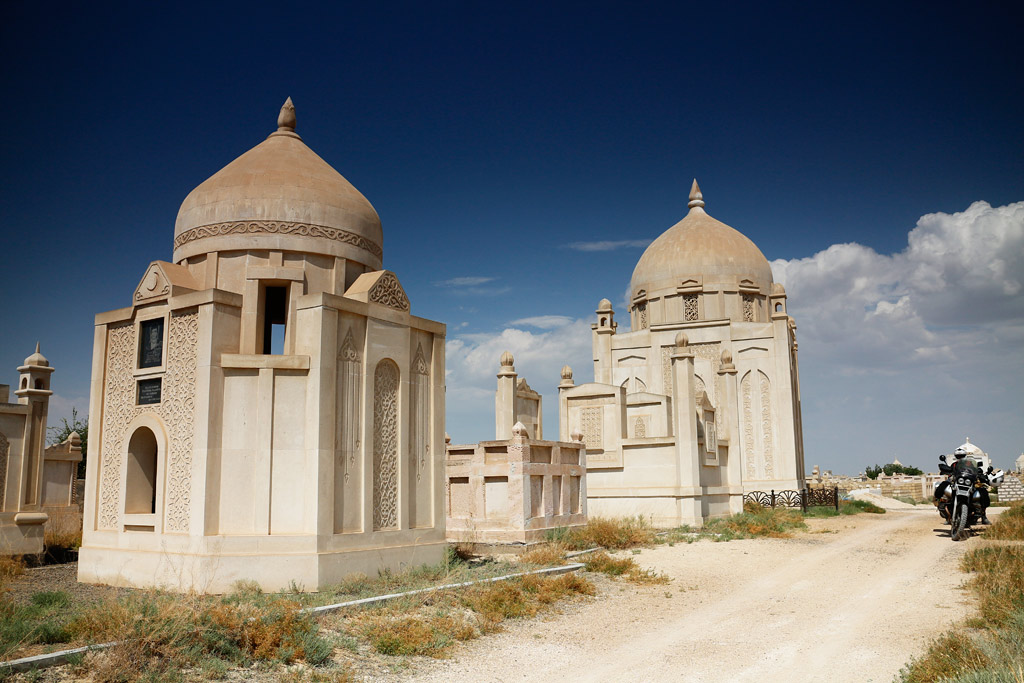
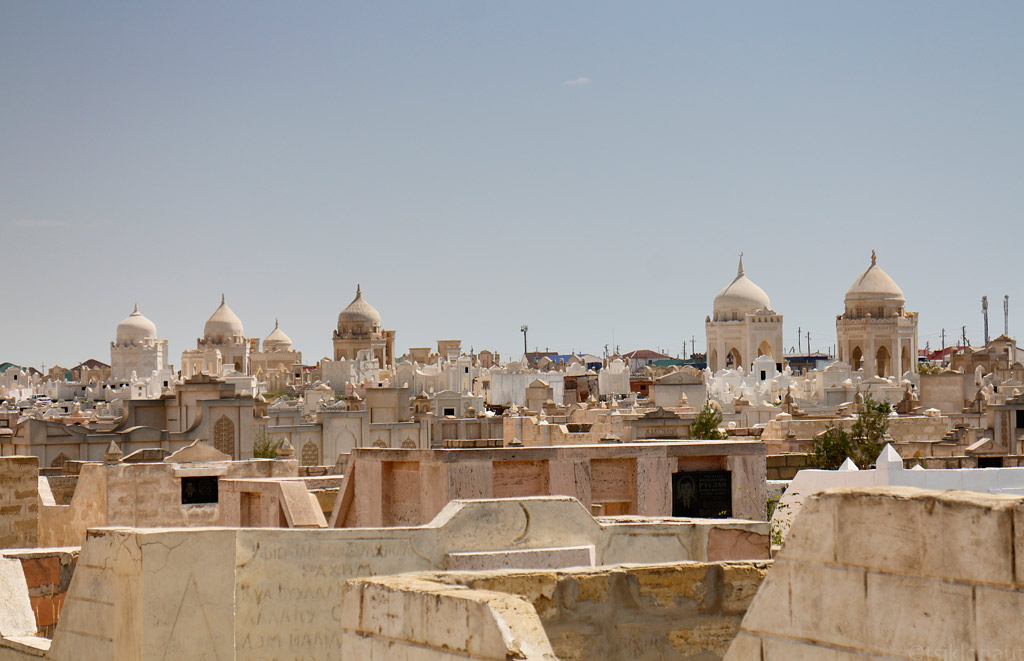
We didn’t linger too long though. Not because of the nature of the place, but because of the heat. It was unbearable. Moving down the highway only offered slight relief as we felt like riding in a heated oven. Opening the visor in order to get more air produced made us feel like being targeted with a heat gun.
Luckily, the road was smooth and there was virtually no traffic. The only thing to watch out were the camels. But there weren’t exactly many of those either.
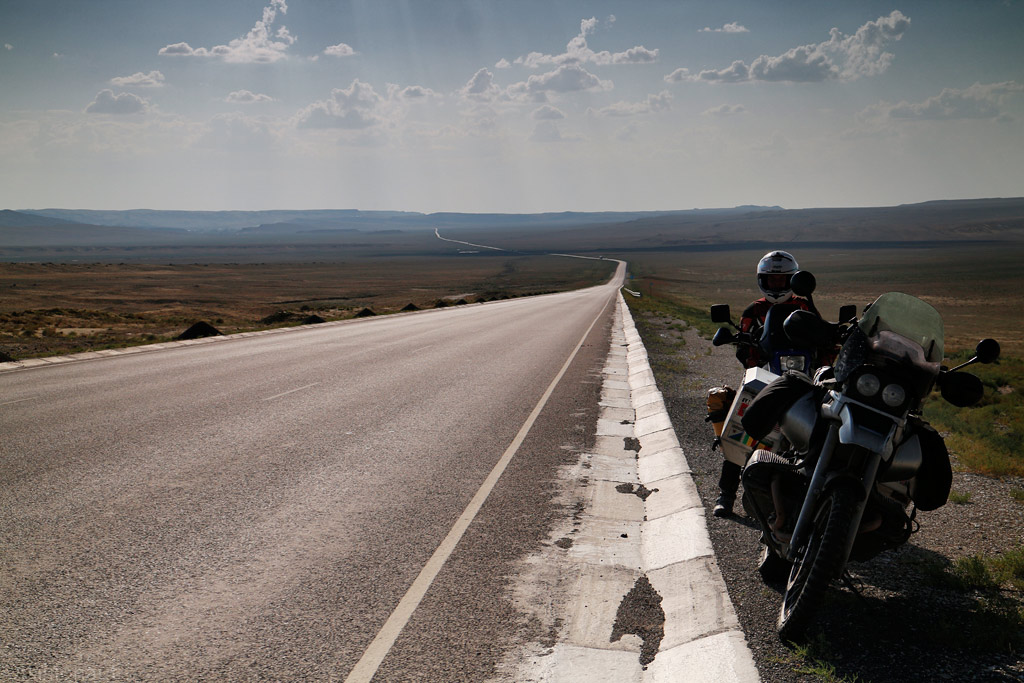
The roads in Kazakhstan can be very good...
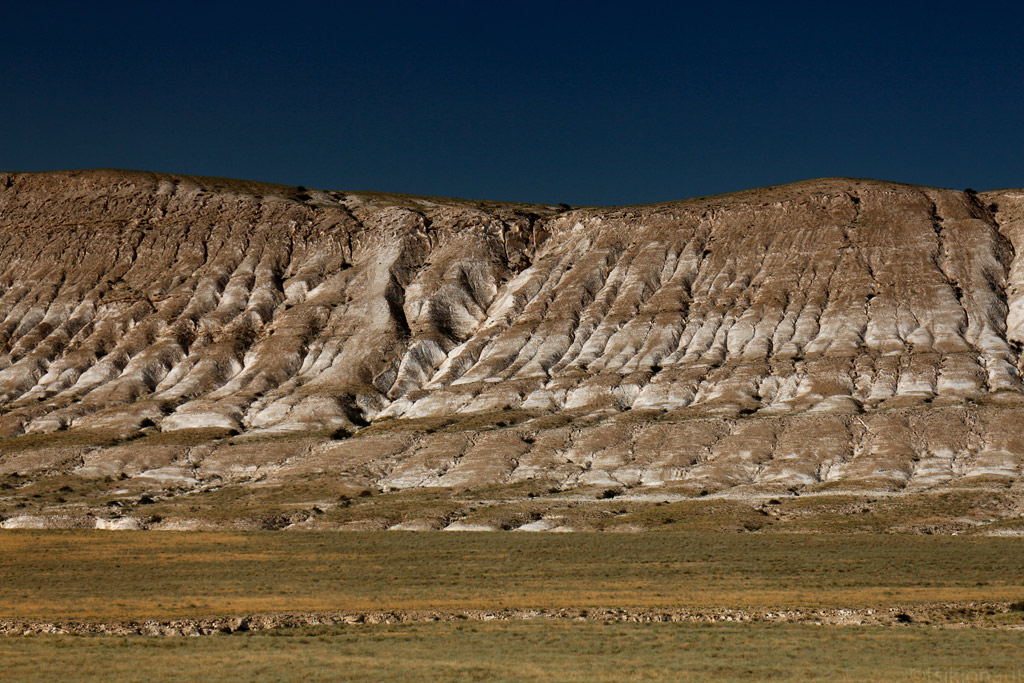
Mangistau landscapes.
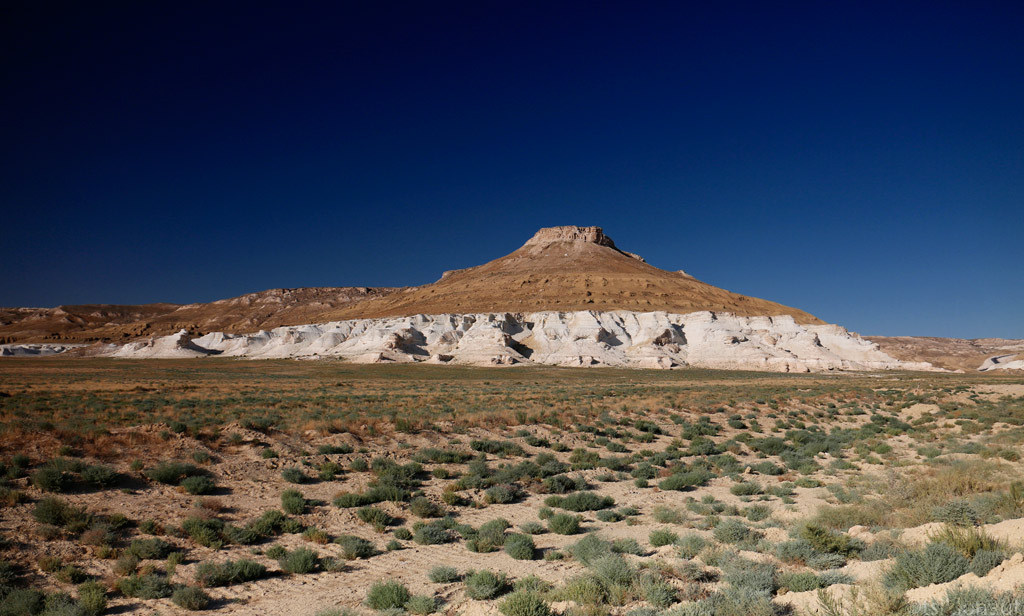
Mangistau.

After some 300 kilometres of riding through the steppe, with only one truck stop in-between, the Sun was low enough for us to start thinking of stopping for the day. With the vast, empty steppe expanding in all directions we simply turned off the highway and made our way through the low grass. After a few kilometres, with the road still in sight but relatively far away, we stopped.
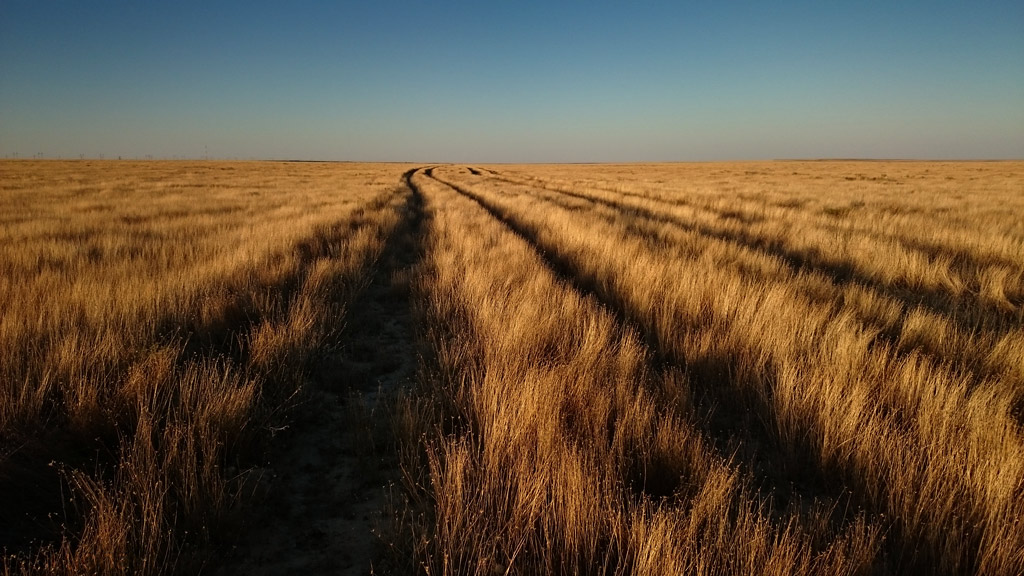
You can literally ride hundreds of miles of this...
The lower the Sun hung above the horizon, the quicker the temperature dropped. We cooked some instant soup, pitched the tent, used a bottle of water for showering and enjoyed ourselves.

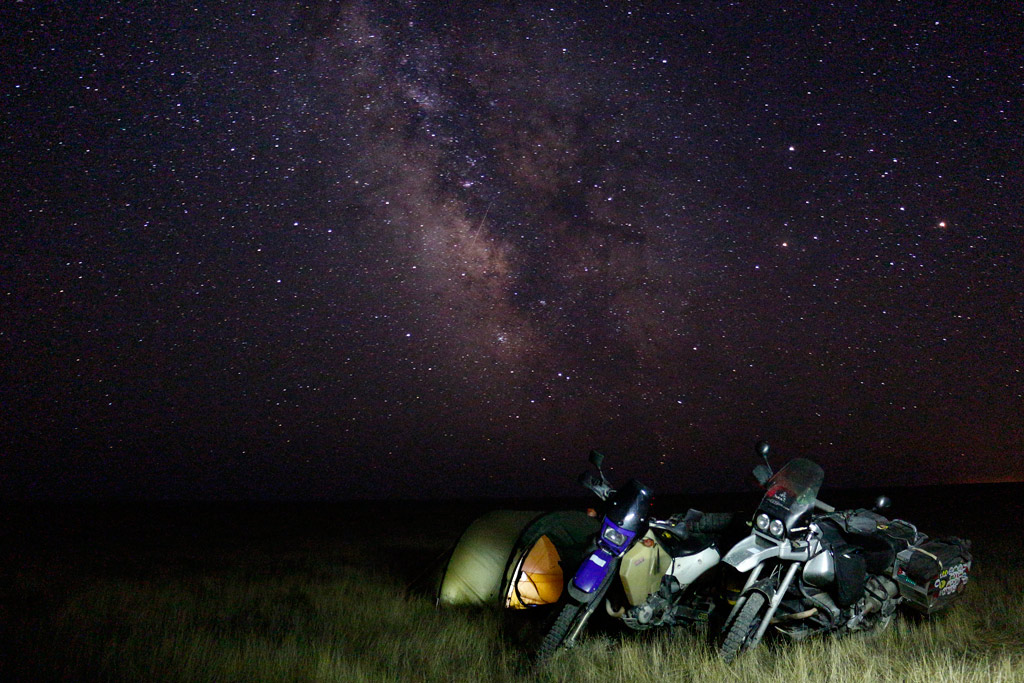
After the Sun had set, it became dark really quickly and countless stars lit up the sky… What a fantastic way to spend a night in a steppe!
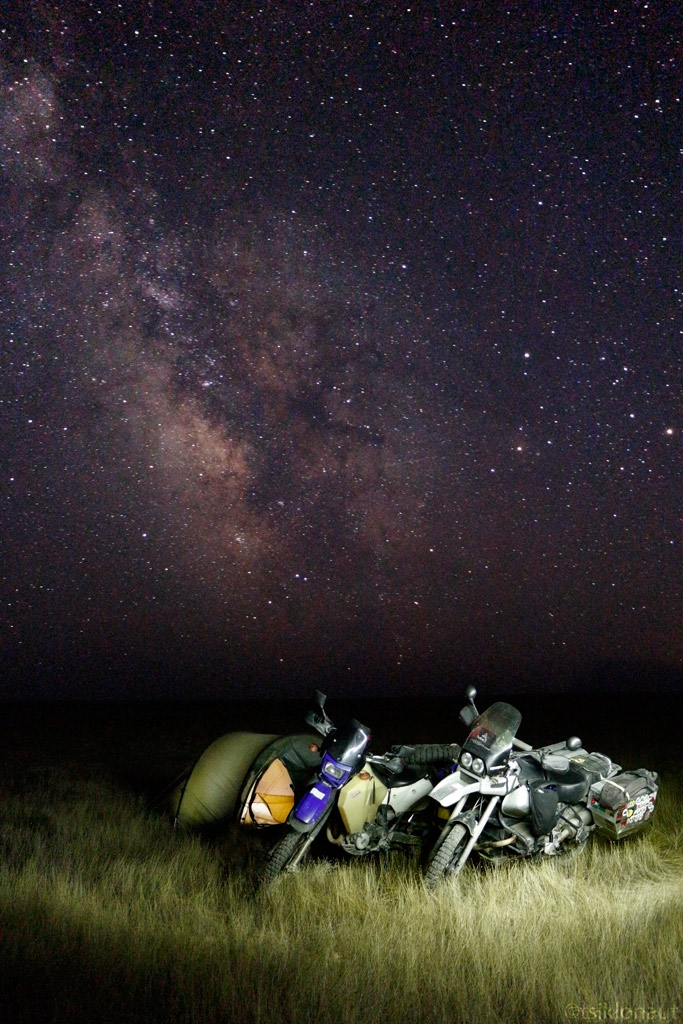
Our Galactic Standard Million Star hotel suite (shared together with poisonous spiders, scorpions, snakes, lizards and other friendly bugs we encountered - unlike some, in a free nature we actually respect and love 'em all!)
At night the temperature must have dropped to +25 degrees Celsius (versus some +35 in the daytime), so it was very comfortable to sleep. Getting out of the tent minutes before sunrise we could almost say it was cold! However, as the Sun rose and started making its way up, the temperatures soared again.
We moved on towards Uzbekistan, down a very bumpy dirt track. All the time in the first or the second gear.
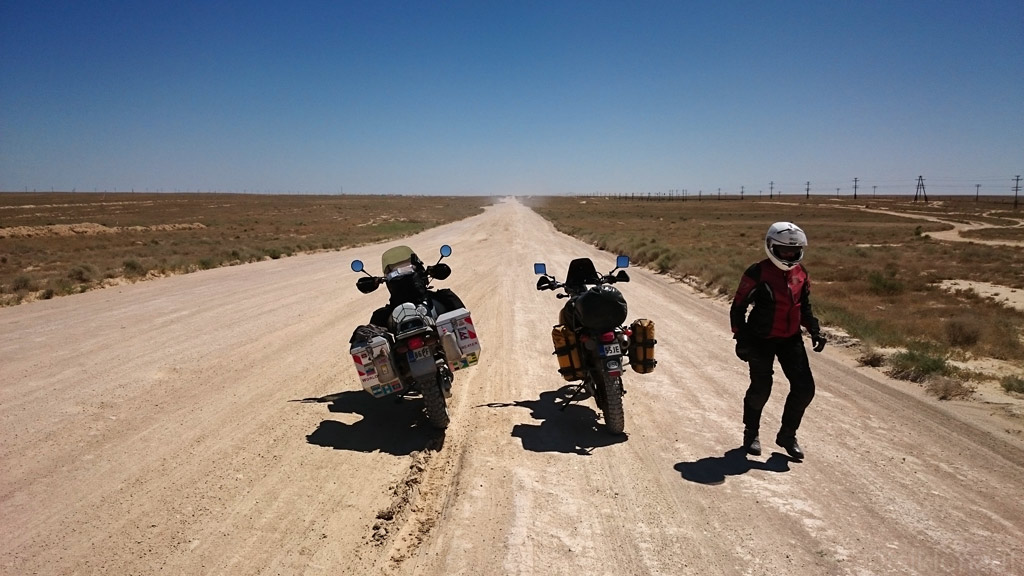
Hardened mud track to Uzbekistan border.
After entering Uzbekistan through a rather remote border post we rolled down a reasonably paved road that took us through… nothingness. Around a hundred kilometres passed without passing by any kind of village, roadhouse, and not even a camel. It was hot though, and our thirst grew by kilometre, so when our eyes finally came across some village on the horizon that wasn’t even on our maps, we willingly took the some five-kilometre detour to get there.
We had barely managed to park our bikes in front of the village store and go in to buy cold sodas, as seemingly half of the village gathered around us. Soon enough we and the villagers were posing for photos in front of our bikes. One of the fellows ran into the store and coming out of there with two bottles of cold beer, insisted that we take them with us as a present. What an introduction!
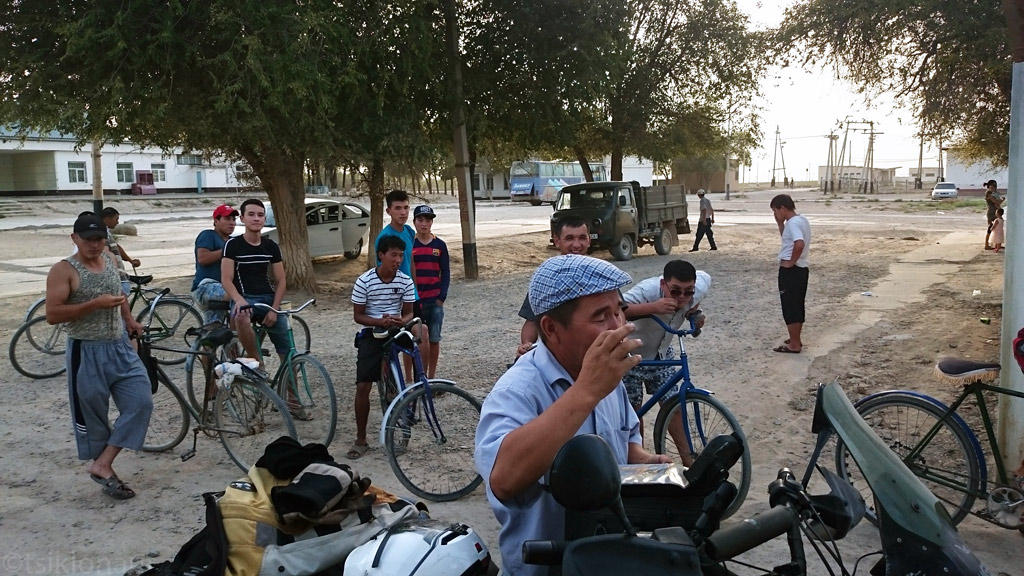
As the Sun was about to set, we rolled out of the village and a couple of kilometres down the highway before getting off the road and into the semi-desert. After around a kilometre of some nice riding through the dry landscape we decided to stop and pitch our tent.
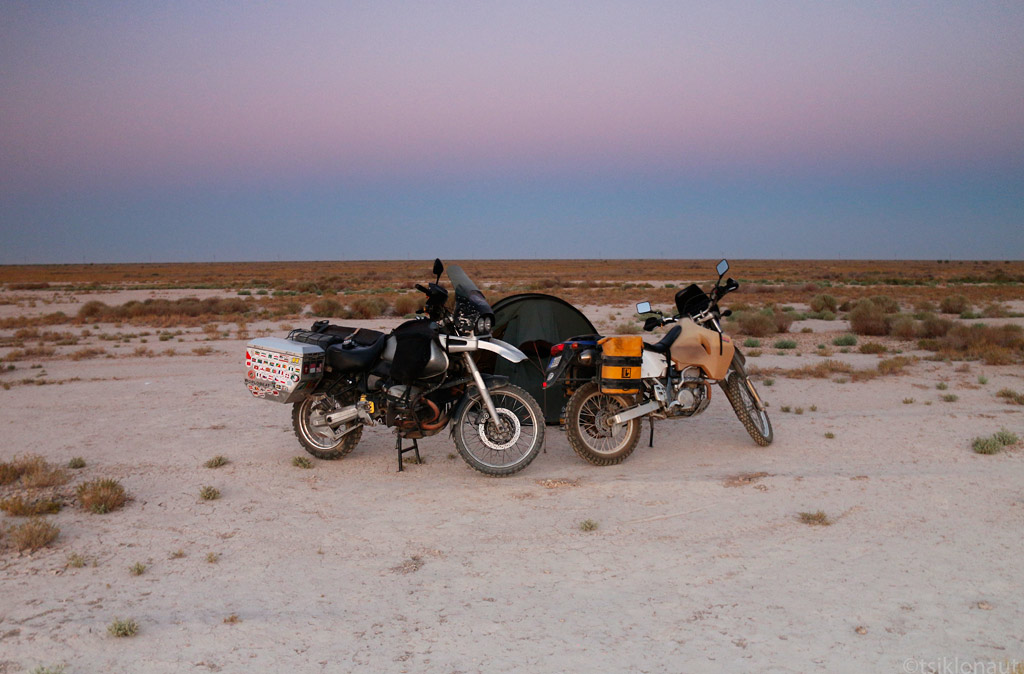

Our Uzbek desert friend wanted part from our morning coffee, but we discovered her when we've already finished.

The next day we arrived in Kungrad (or Qongirot - the spelling of place names can be really confusing in Uzbekistan) from where a road branches off towards the town of Moynaq that used to lie on the shores of the Aral Sea. But before we could set off for Moynaq, we had to face a problem that we’d have throughout most of Uzbekistan - there was no petrol. The only fuel station selling petrol was not working due to a power cut, and the rest were only selling gas (most cars in Uzbekistan run on gas so there is basically no demand for petrol). Somehow we managed to track down some guy selling petrol in canisters from his backyard, and could continue our journey.
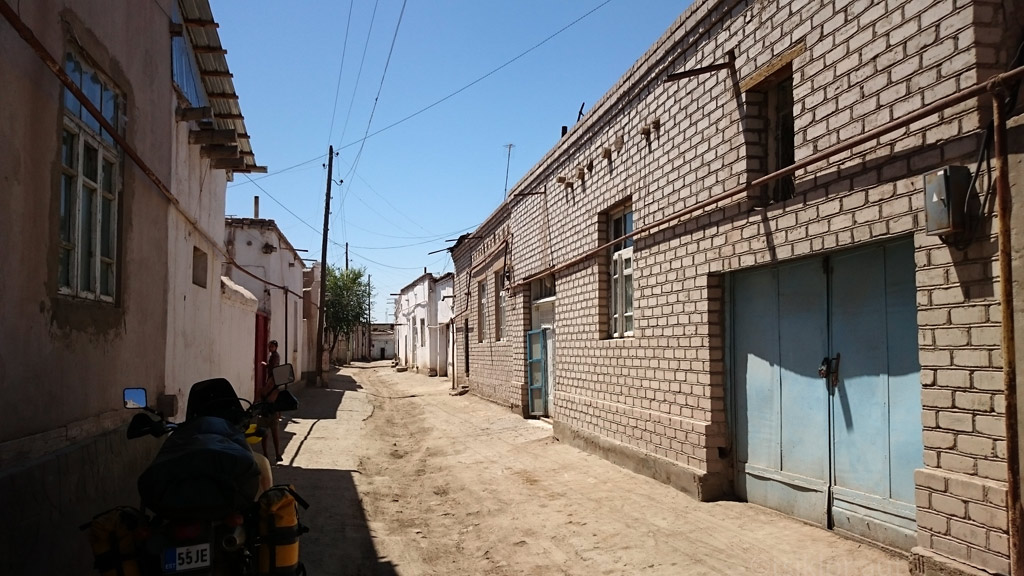
Searching for fuel in Uzbekistan villages...
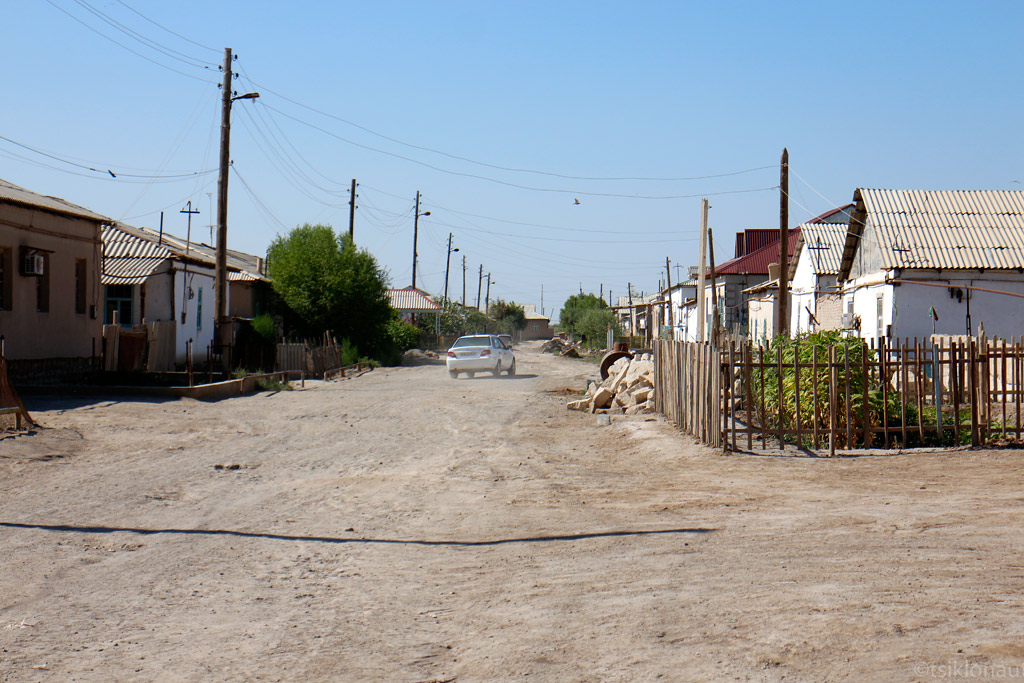
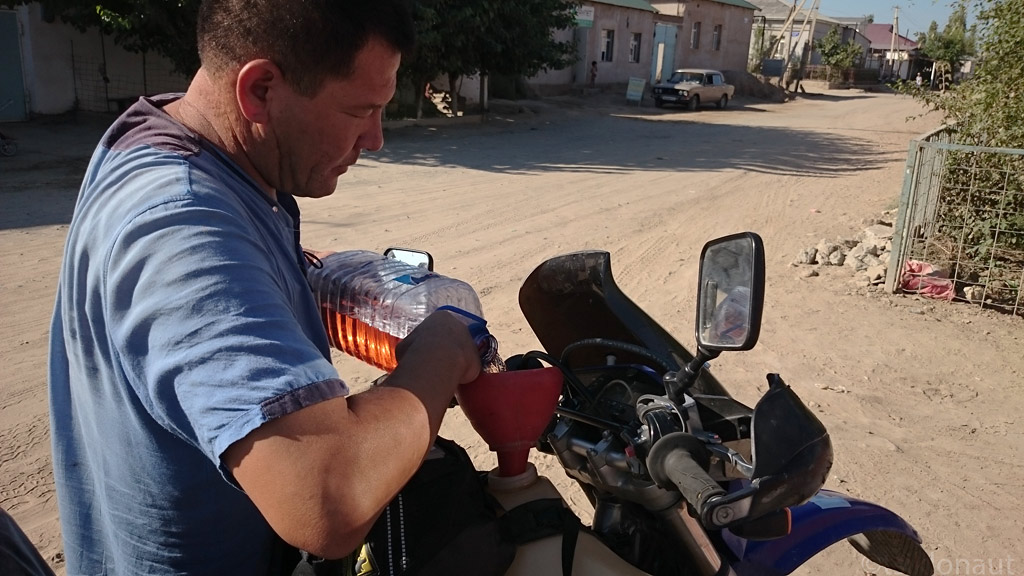
Finally after a lot of search found one guy selling us few liters from his backyard.
Moynaq is a town with a grim story to tell. It used to sit on the shores of the Aral Sea (hence a fish on its logo), but after the development of cotton production in Uzbekistan drained the rivers that used to feed the sea, it shrank to a mere fraction of its original size. Today one cannot even glimpse the water from Moynaq. Instead, what used to be the sea bed is now basically desert that is covered with low shrubs that grow as far as the eye can see. The rusting ships serve as a reminder of the catastrophe.

Rusting ships on the dry Aral sea, one of the biggest eco-disasters man has ever created.
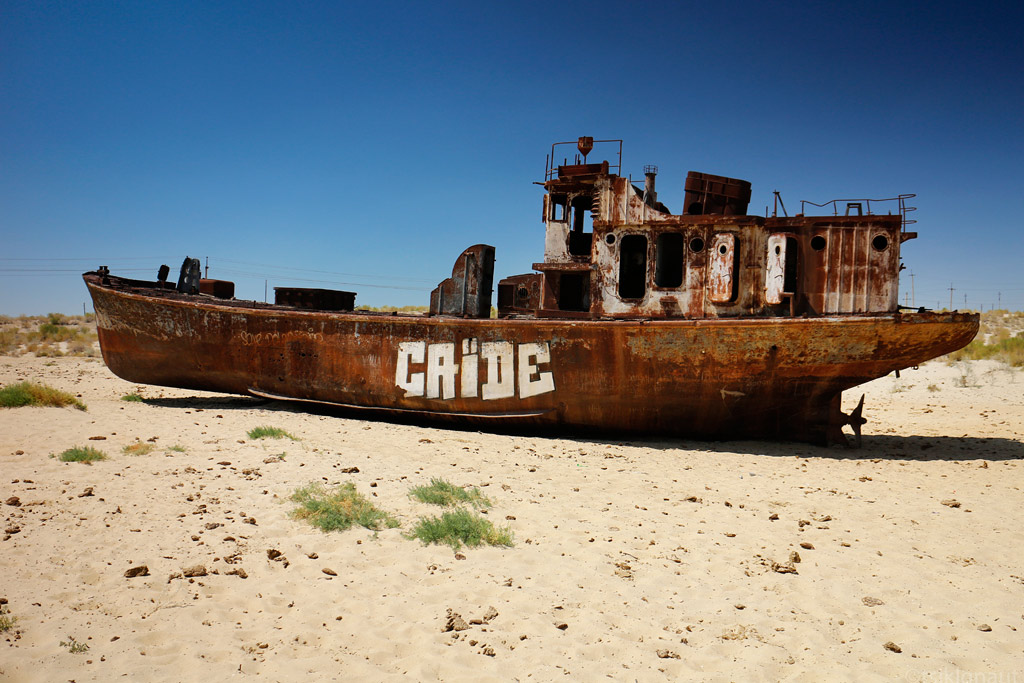
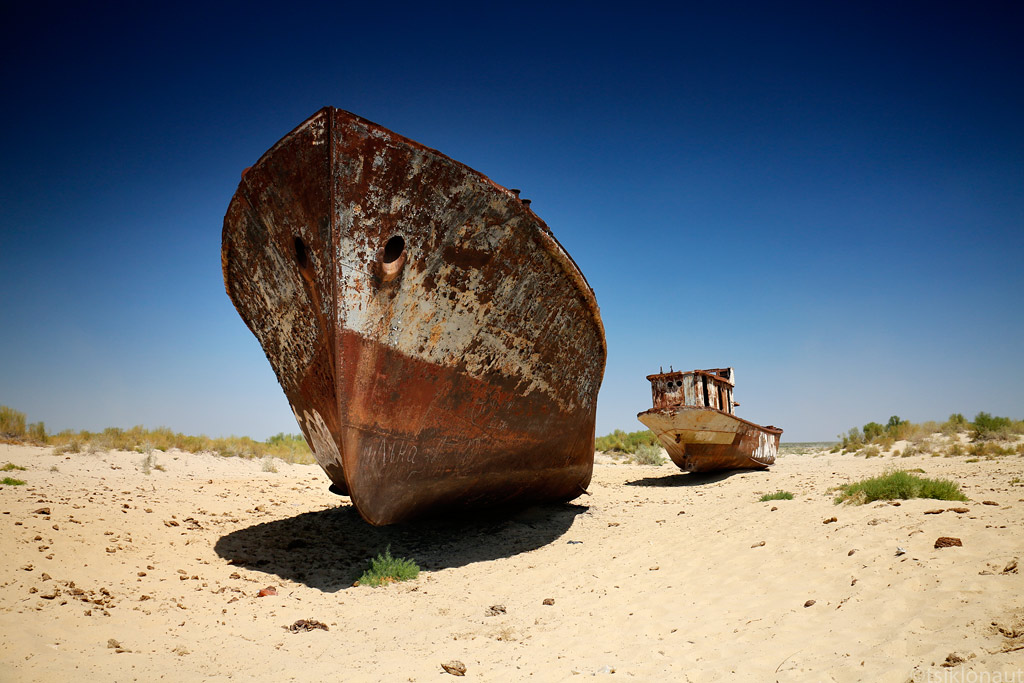
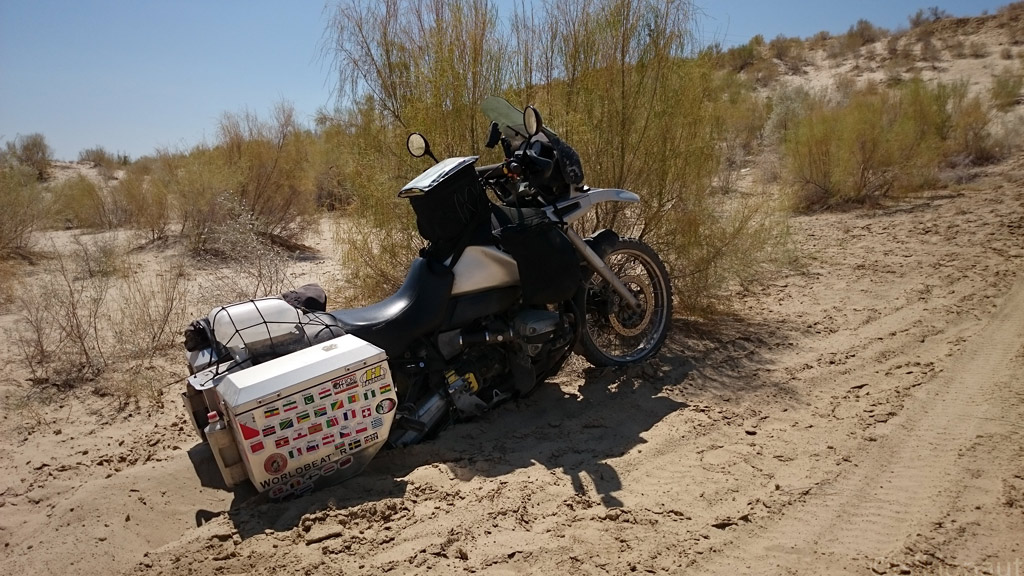
I simply had to take a ride around the Aral sea bottom. A great feeling, but soon I discovered it's a bit too soft sand on some spots....
Back in Kungrad, we spent another hour or two trying to find more petrol to keep us going. After being successful, we rode to Nukus where we had no choice to go to a hotel - the law requires tourists to register themselves within three days of arriving in the country, and to do that one has to stay in a hotel. What looked quite decent on the outside, turned out to be quite different on the inside. But considering that we only paid something like USD 16 for it (thanks to the black marker rate - officially, one night cost USD 30), perhaps it wasn’t that bad.
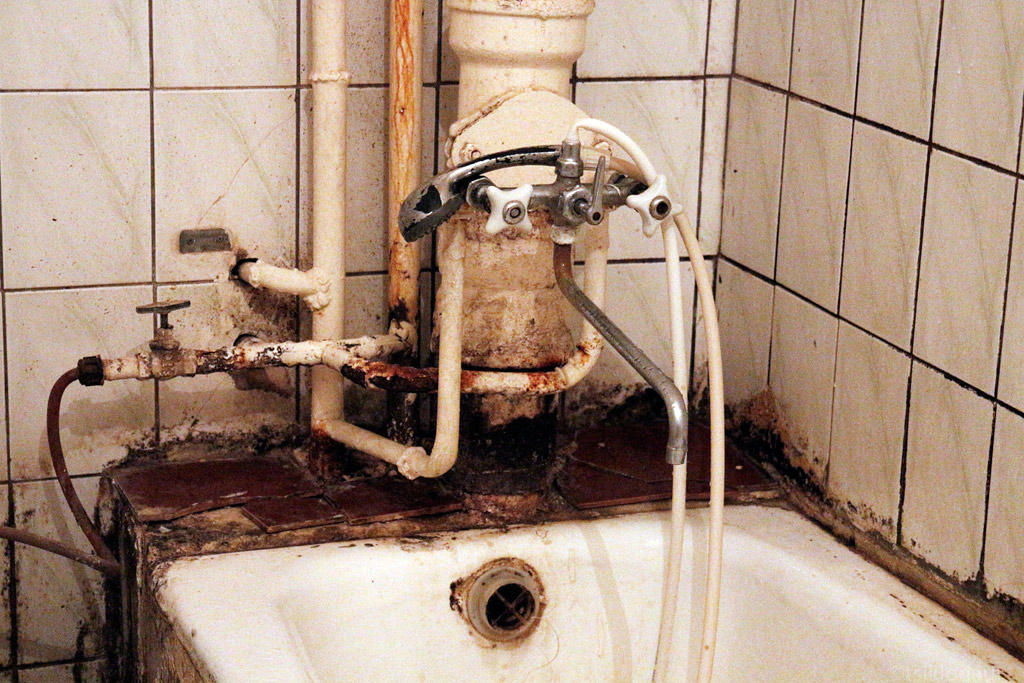
While the western part of Uzbekistan is almost devoid of people, the further east you move the more people there are. And it makes perfect sense - people are where there is water. For example, the famous town of Khiva sits in the valley of Amu-Darya river that separates Uzbekistan from Turkmenistan. Without it, Khiva would have never become the powerful, feared khanate it once was. To us, the mud brick buildings of Khiva brought back memories of the Persian desert city of Yazd, although while the old town of Yazd lives and breathes to this day, Khiva is more of a museum. Its old town mostly consists of mosques, medressas, the governor’s palace and a market.
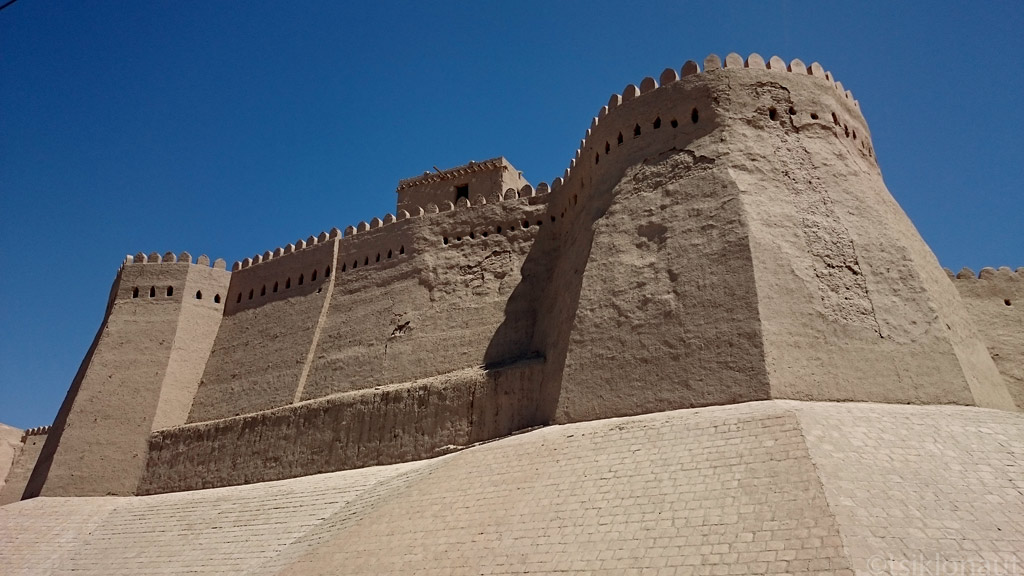
Old city wall of Khiva.
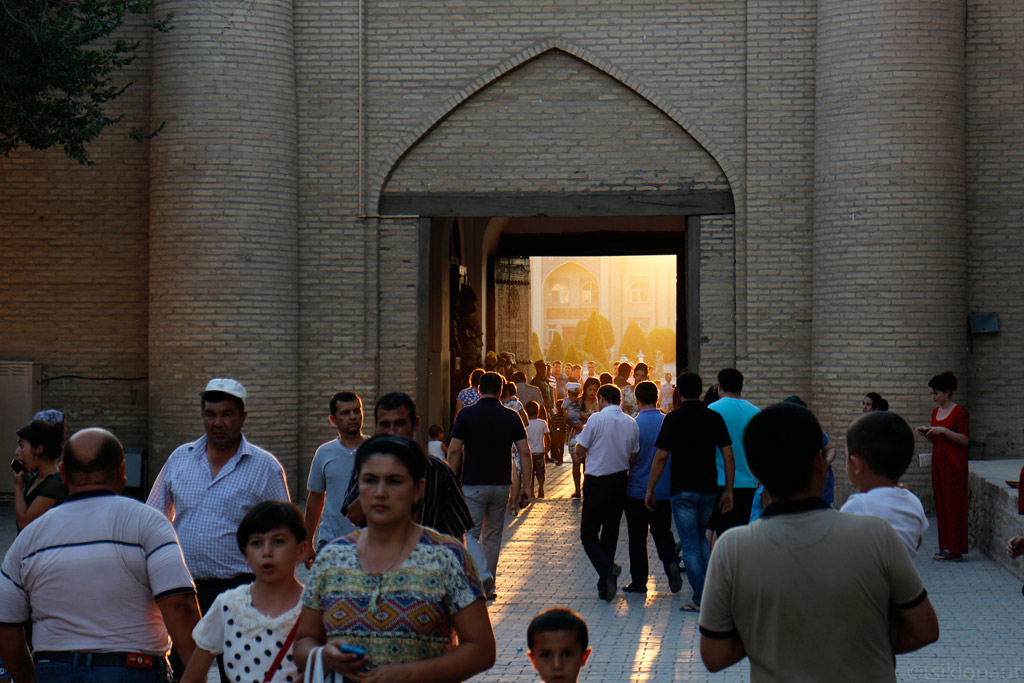
Entrance.
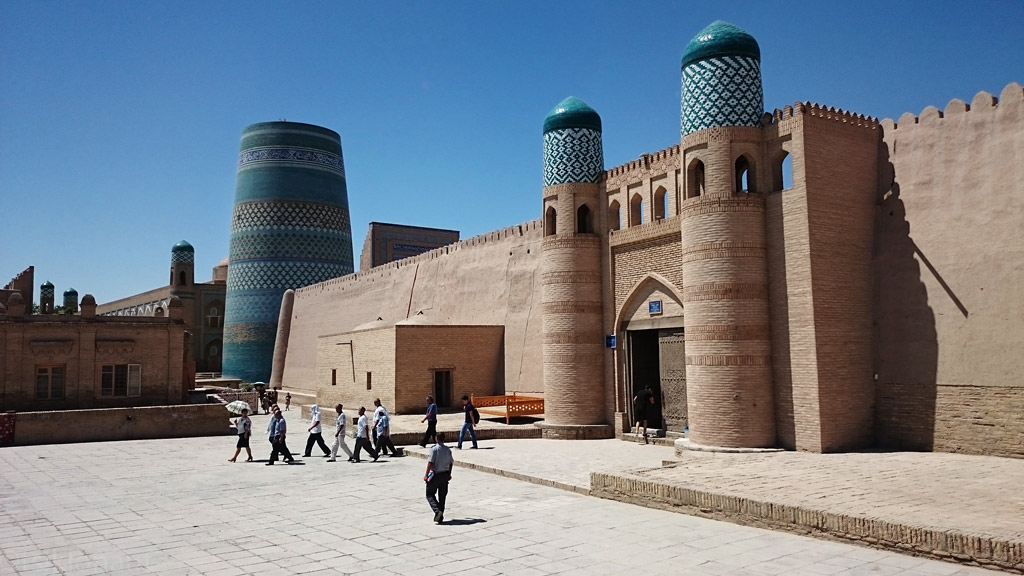
Medressa. Behind, the fat Kalta Minor was ment to be a minaret high enough to see from Khiva to Bukhara, but the ruler died before it was completed.
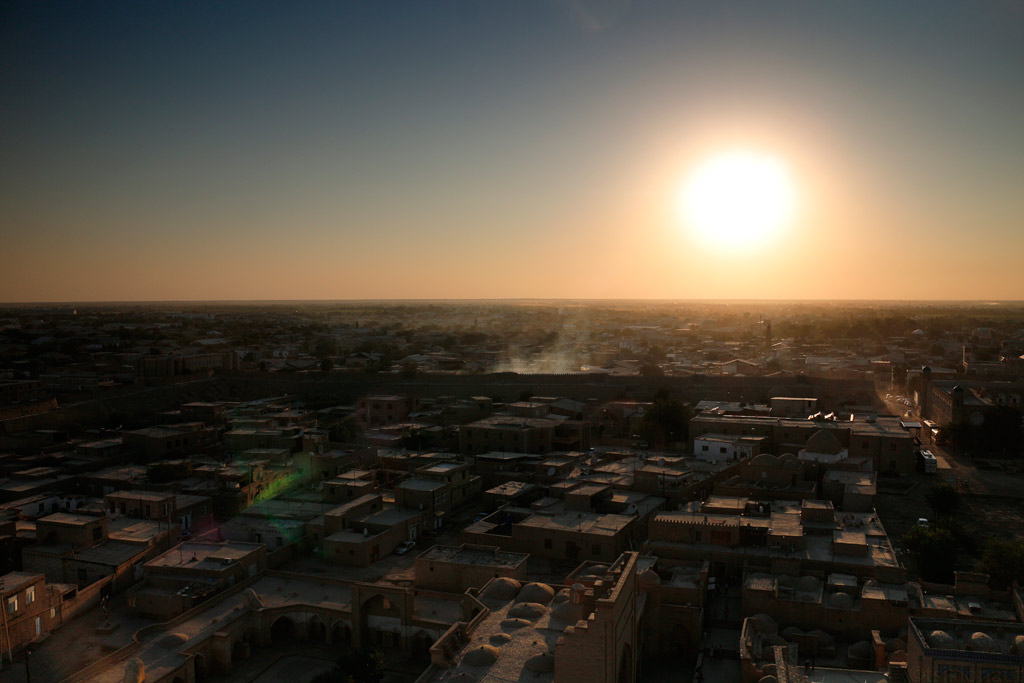
View to Khiva from the highest minaret.
..:: Click to listen soundscape of a live band playing below in the city, with surreal echoes from the mud-walls ::...
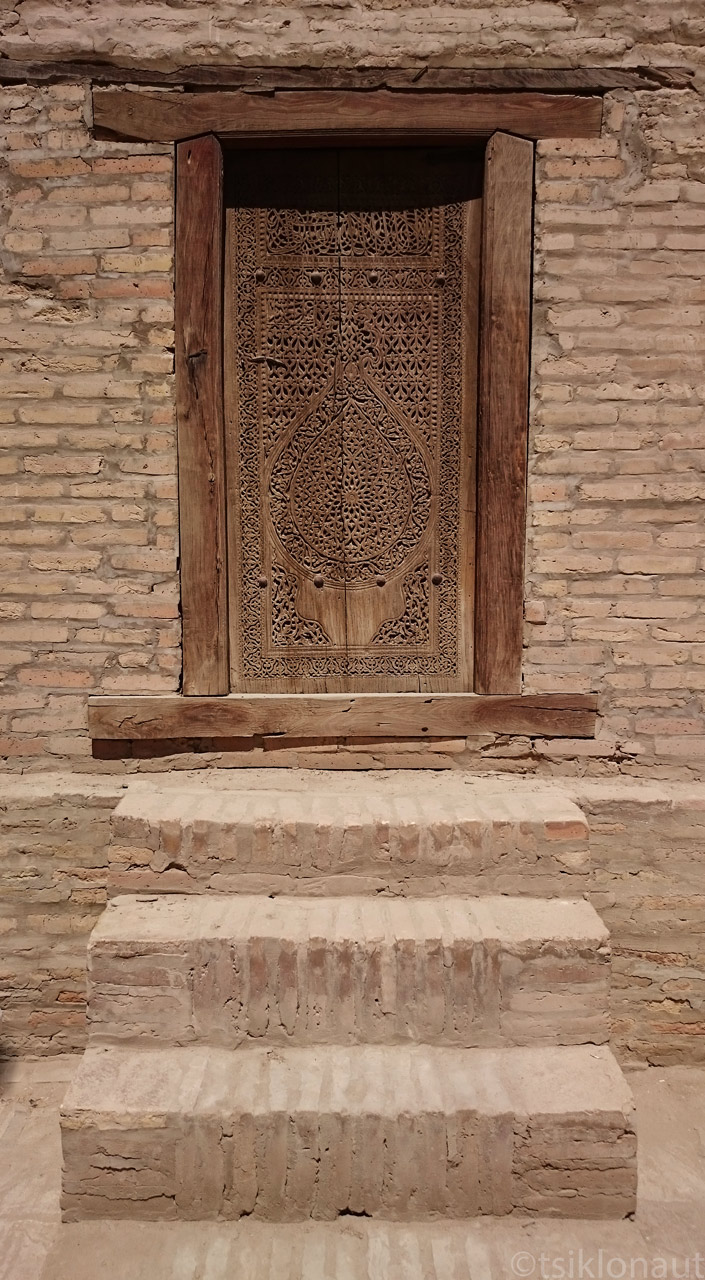
Khivan door.
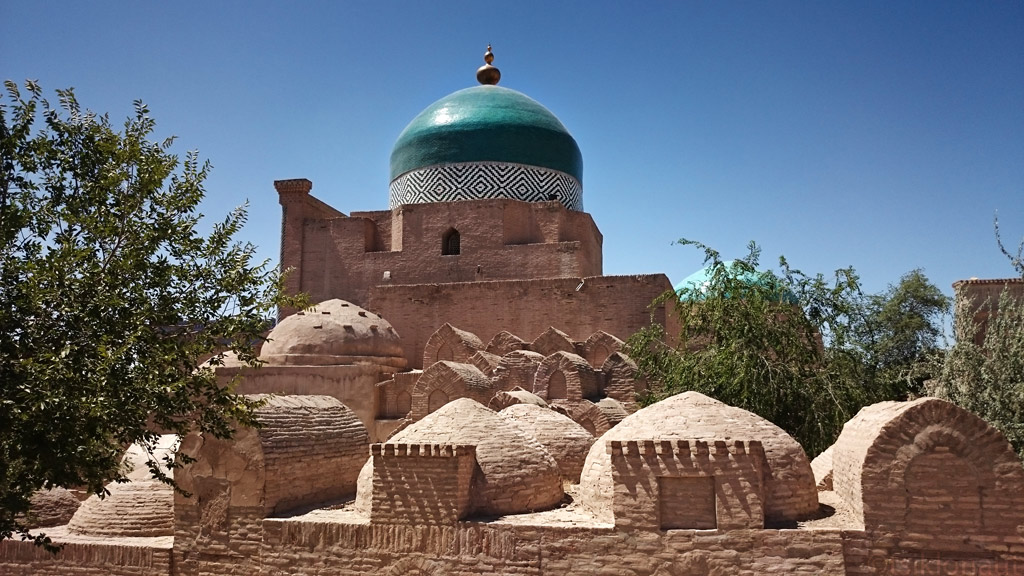
Burials of famous people.
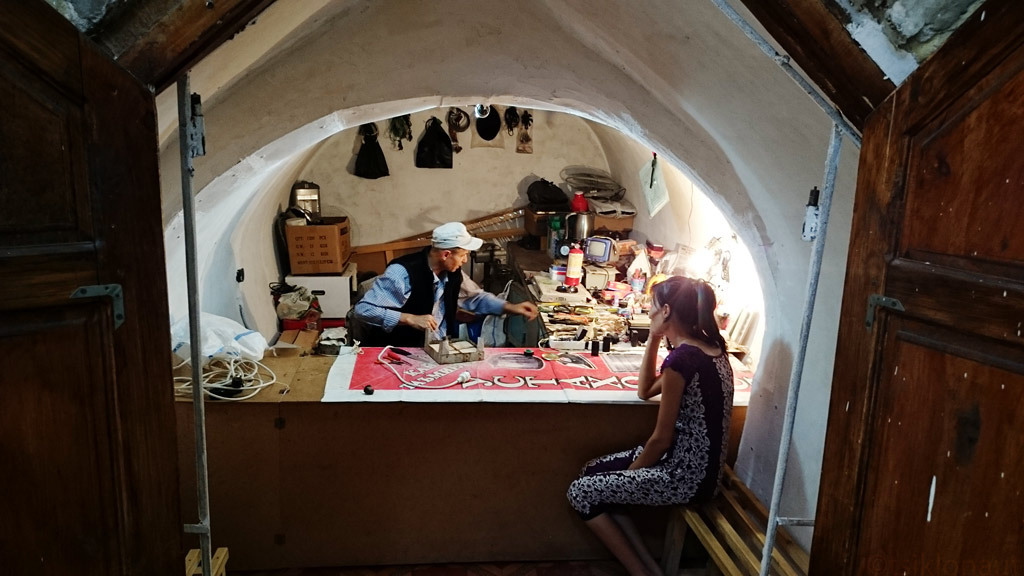
The ex-slave chambers have been nicely converted into small businesses, this one's electronics repair.
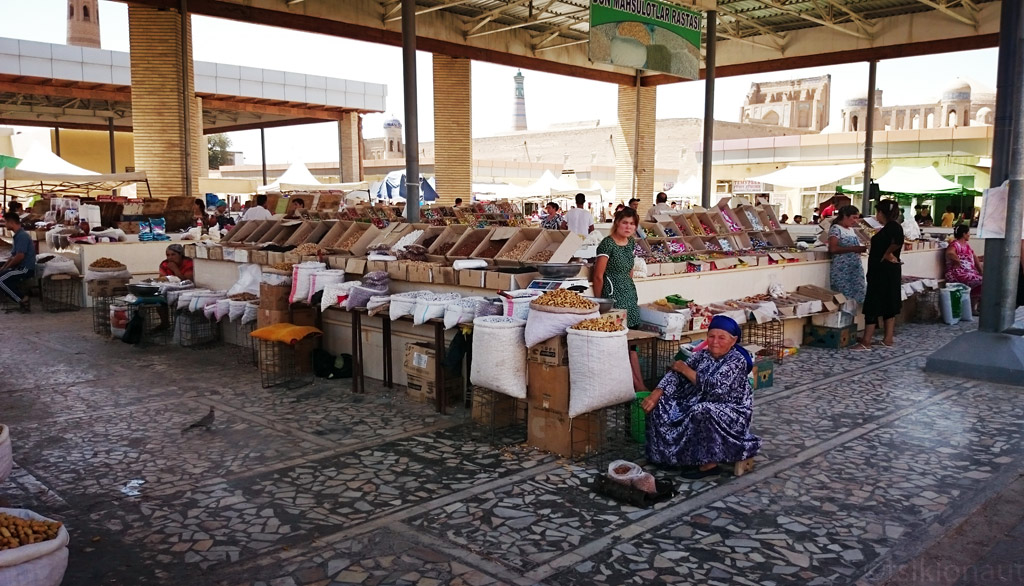
Khiva market - bought some very tasty peanuts from here.
Just like Khiva, both Samarkand and Bukhara were once too built into oases. At first we were stunned by the resemblance of their most famed buildings to those we’d seen in Iran, but found out that they were in fact designed by artists who were forcefully brought to today’s Uzbekistan from Persia. The mosques and medressas we saw in Bukhara and Samarkand are a true work of art.
...:: Click to listen Uzbek street musician for the soundcape ::...
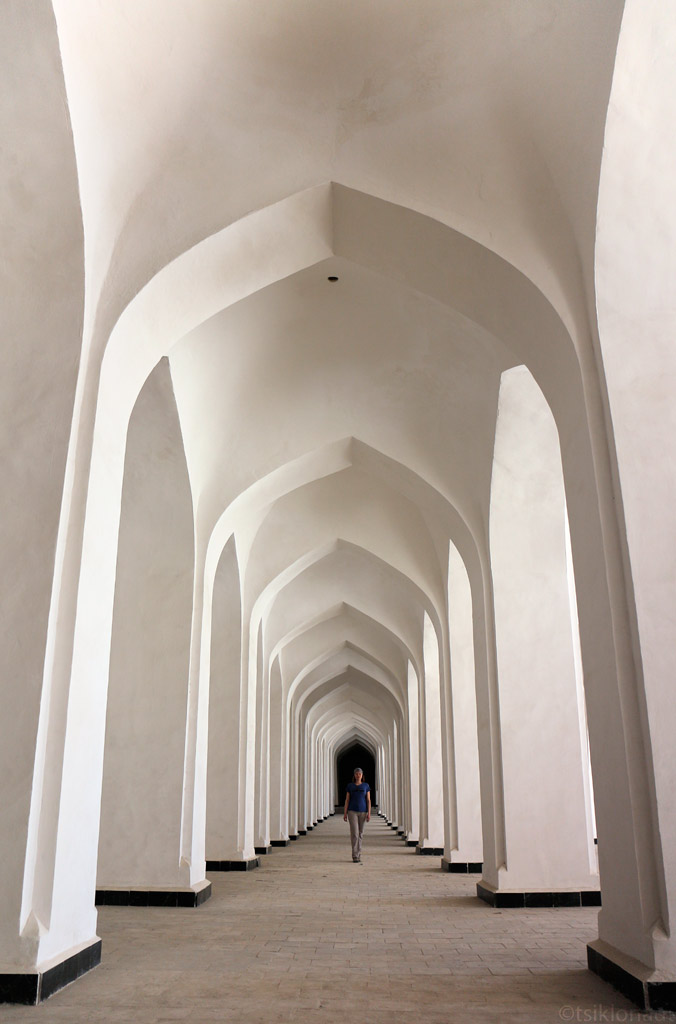
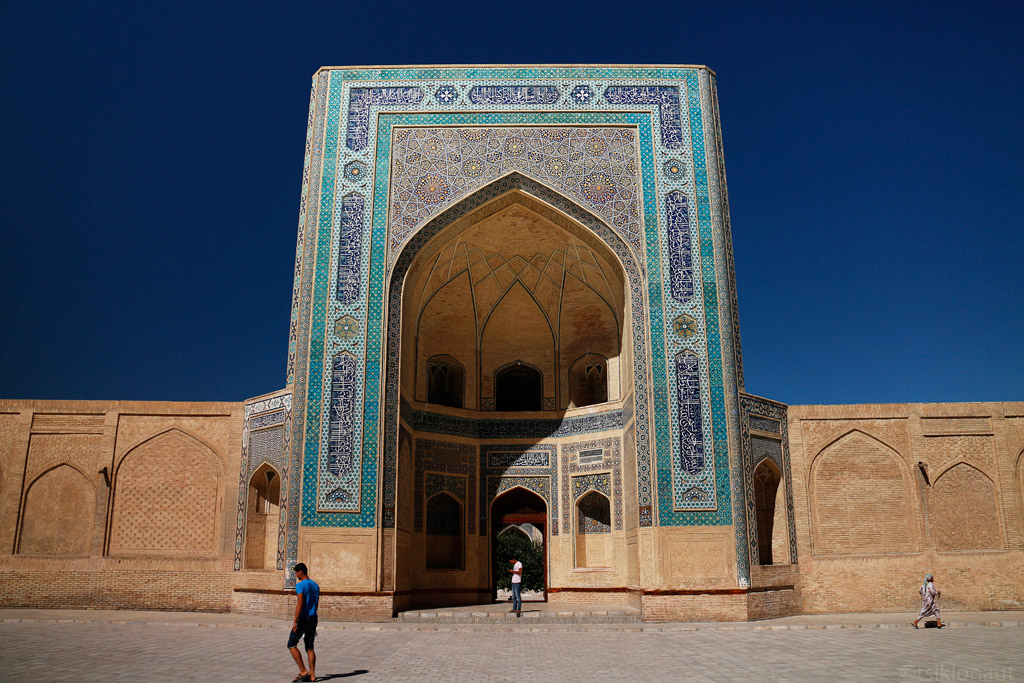
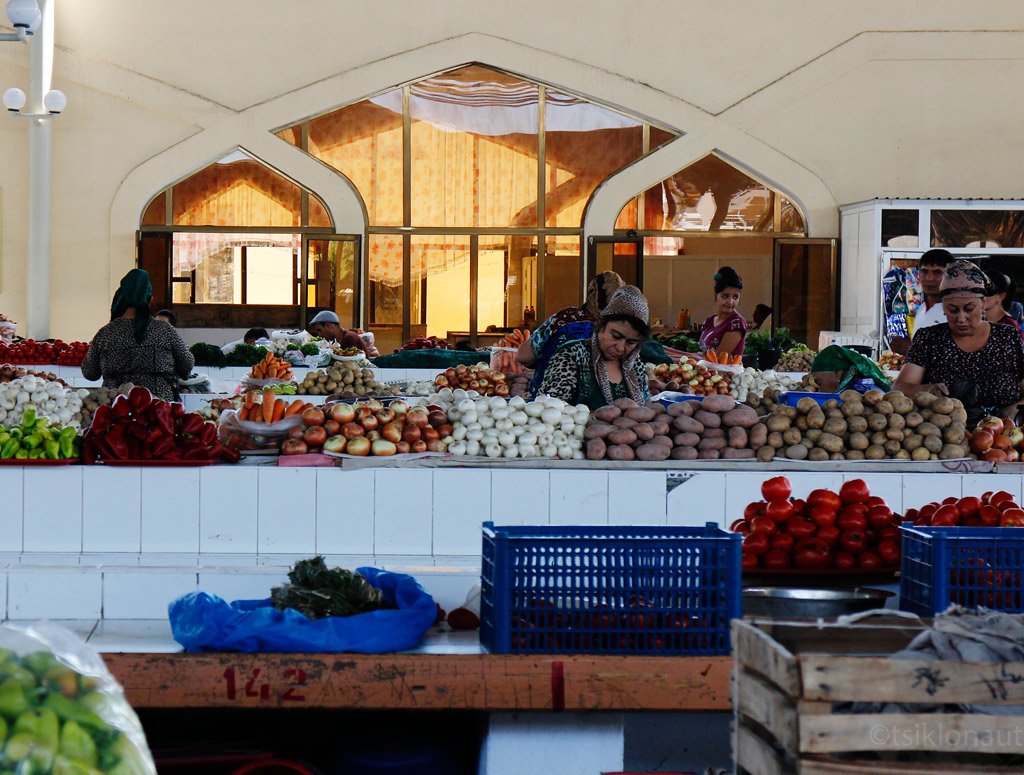
Bukhara market.
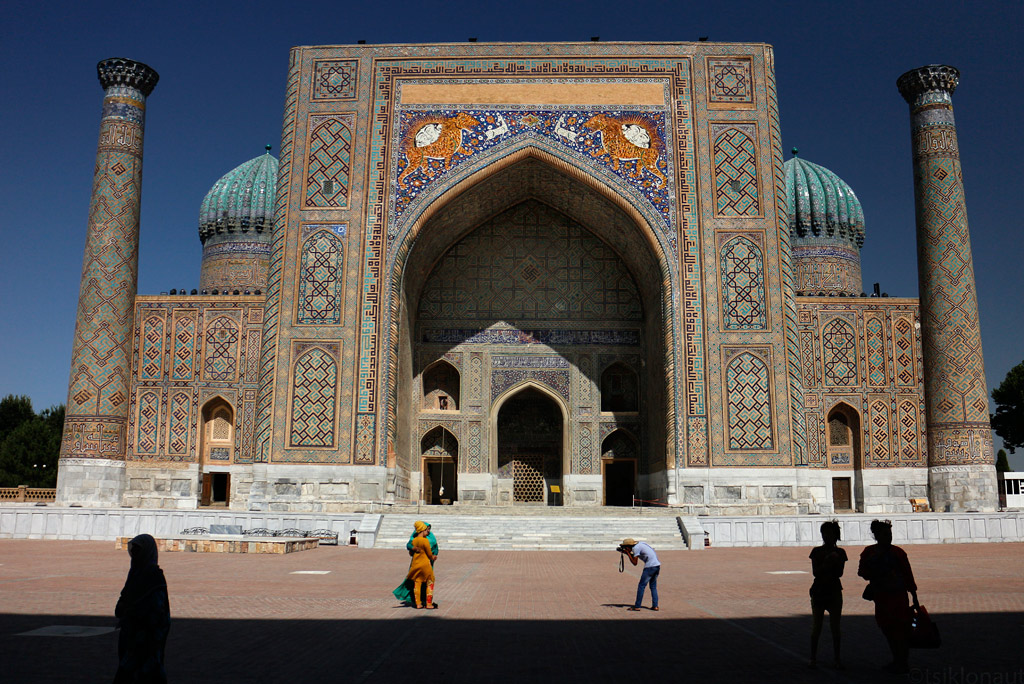
Timurid architecture. This one's actually very controversial among islamic scholars since it draws animals (see the two tigers up), it's a very un-islamic way building things.
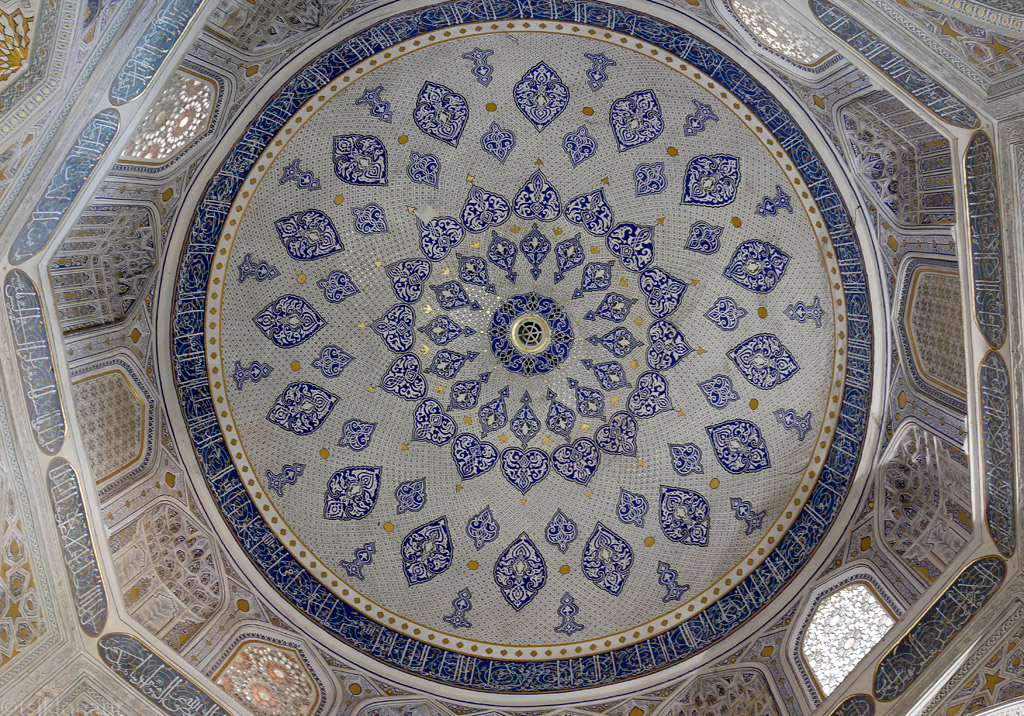
The stunning ceiling of a mausoleum dedicated to Timur's sister.
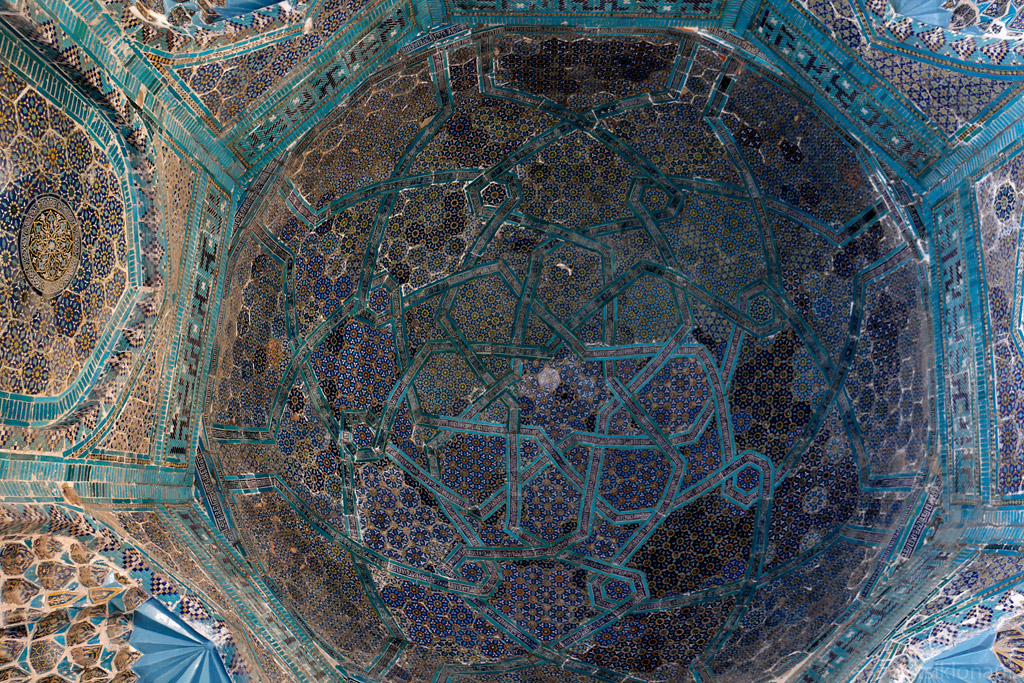
Over a half millennia old, still stunning.
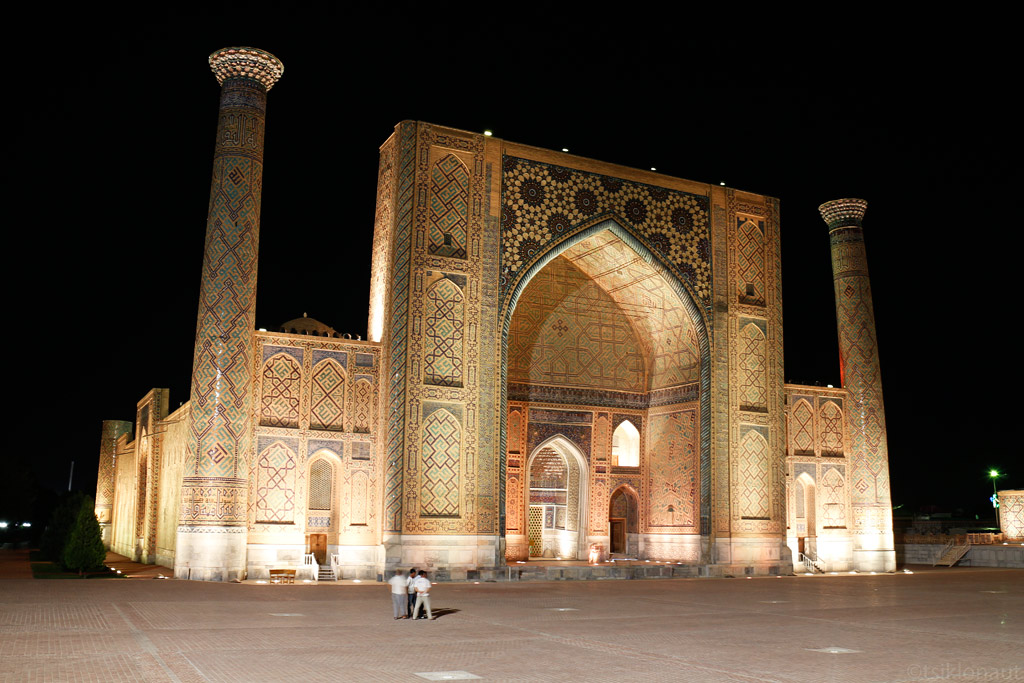
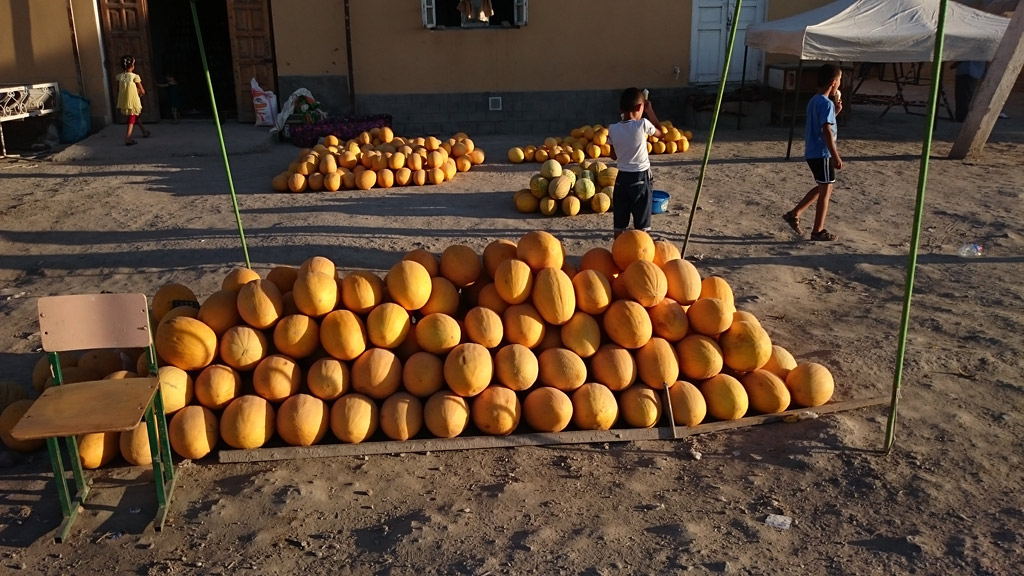
You get very decent melons everywhere, we bought one, it was superb.
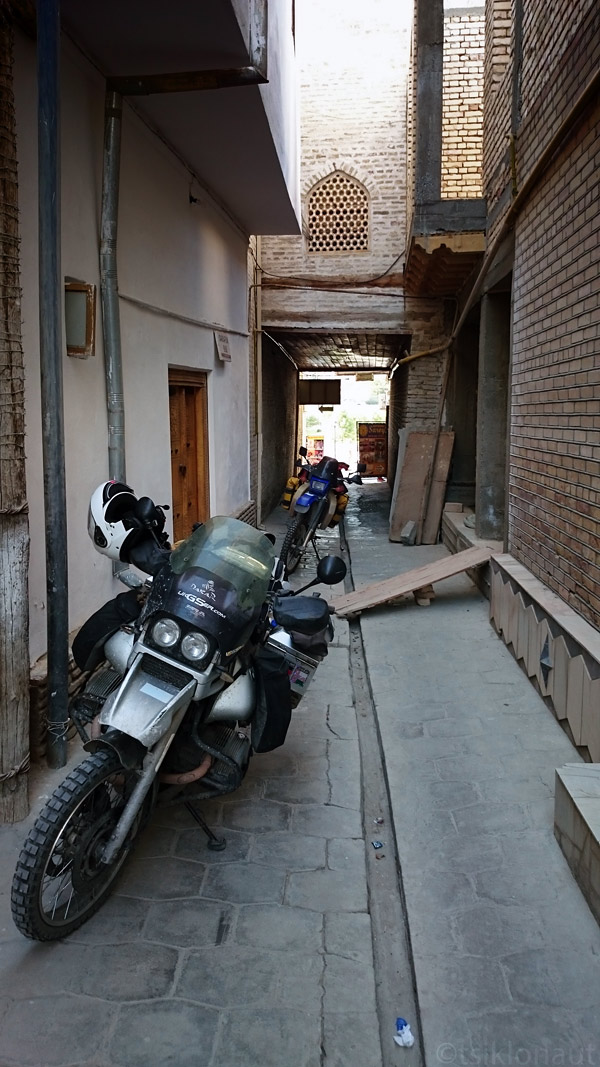
The streets are so tight you can only walk or ride two-wheeled vehicles, as any proper old city should be.
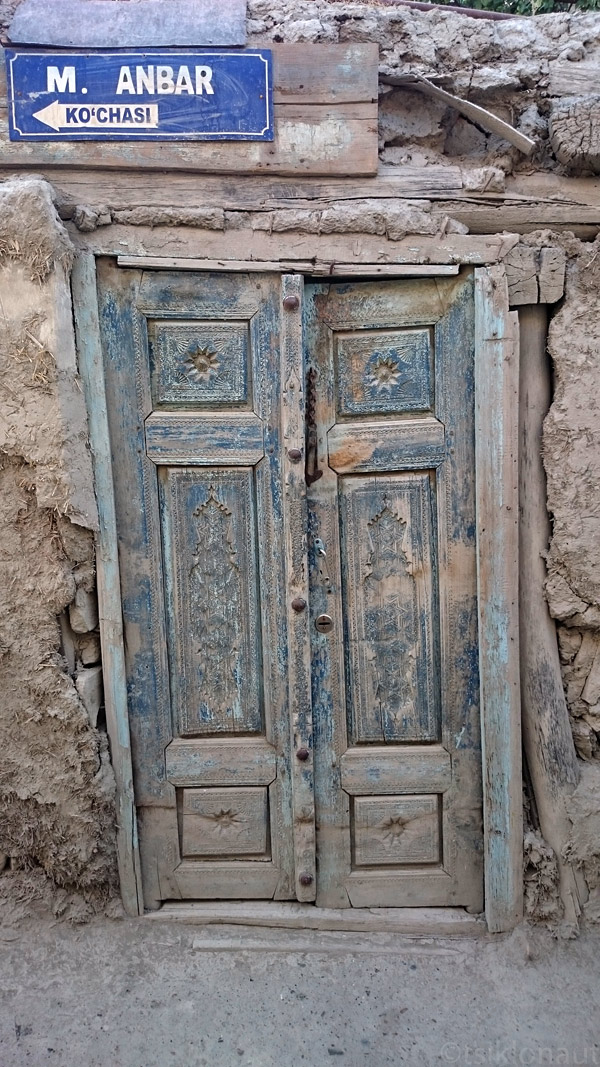
Doorway to someone's home.
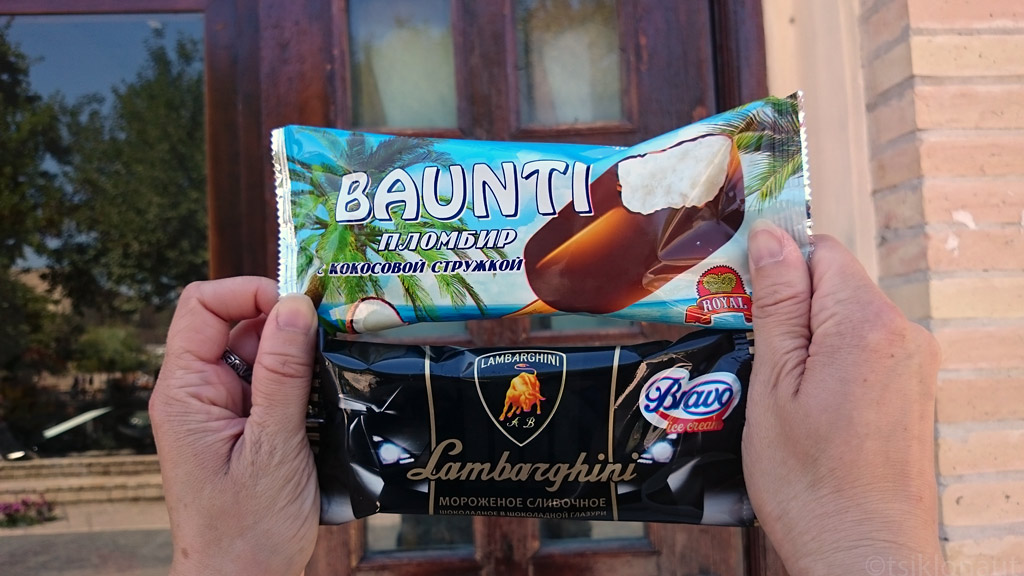
Uzbek ice-cream names are rather funky.
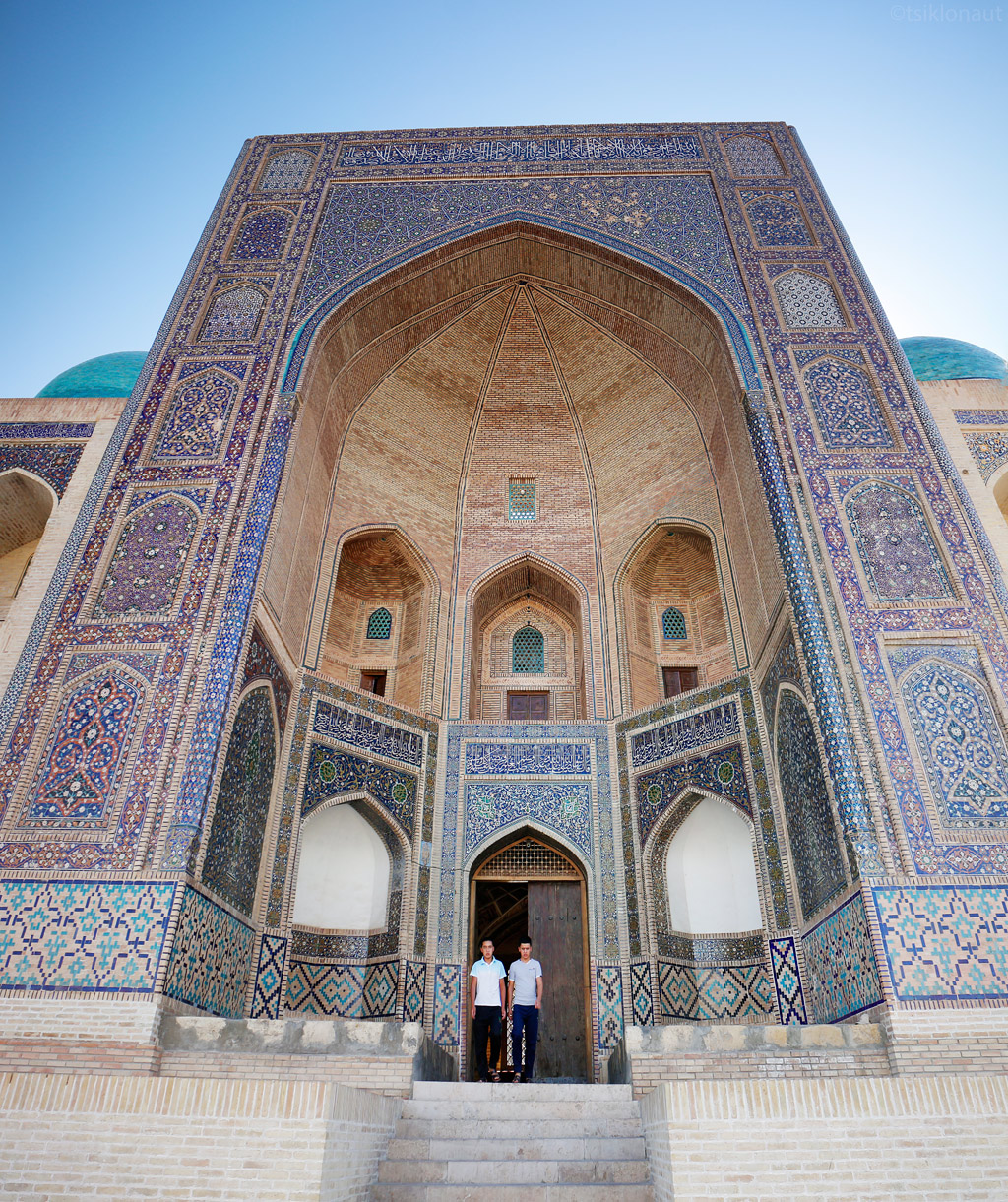
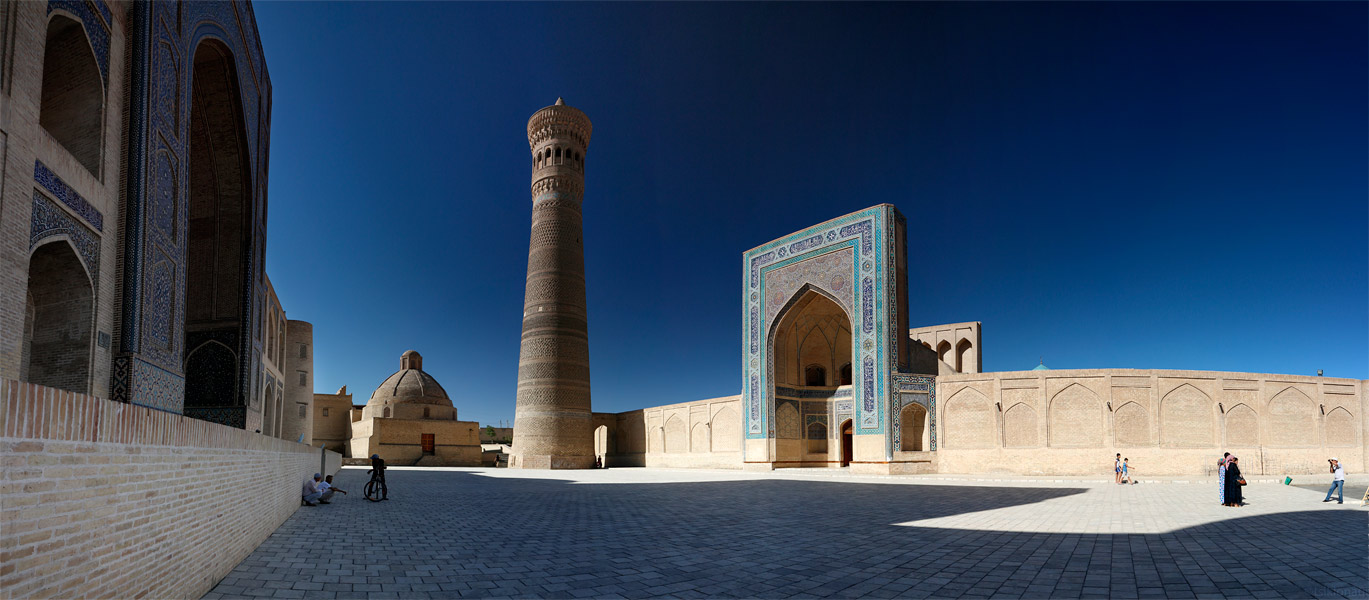
Bukharan city life.
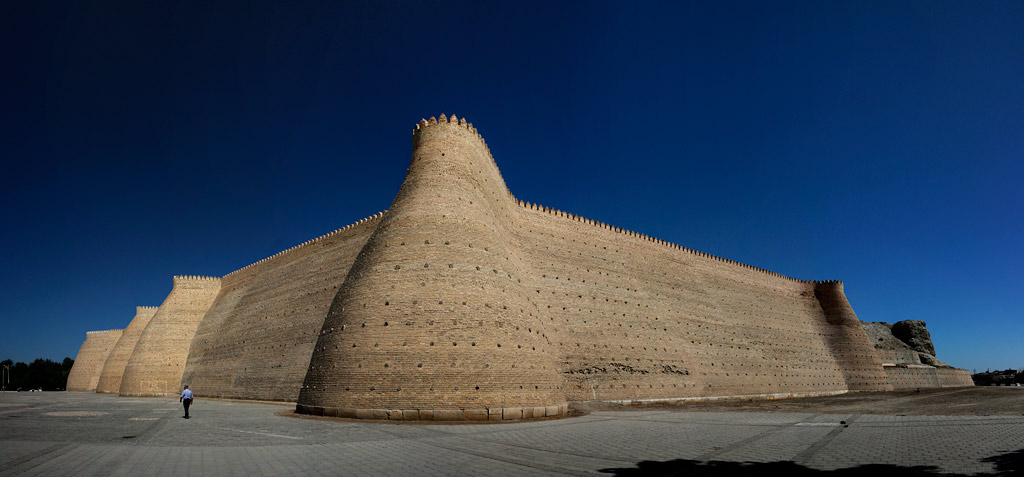
Really impressive fort.
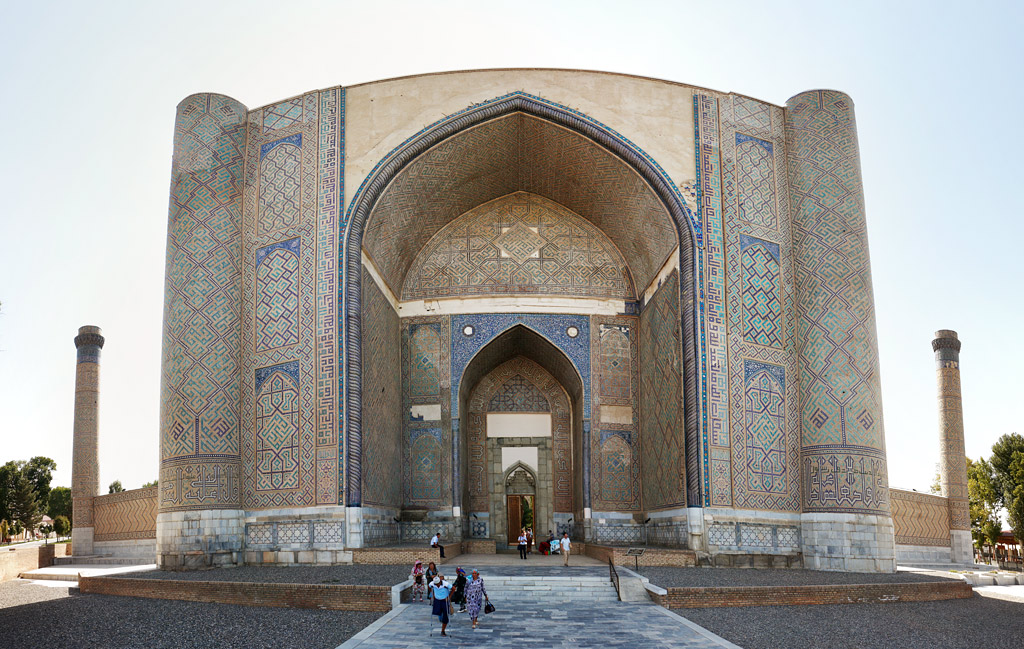
Samarkand.
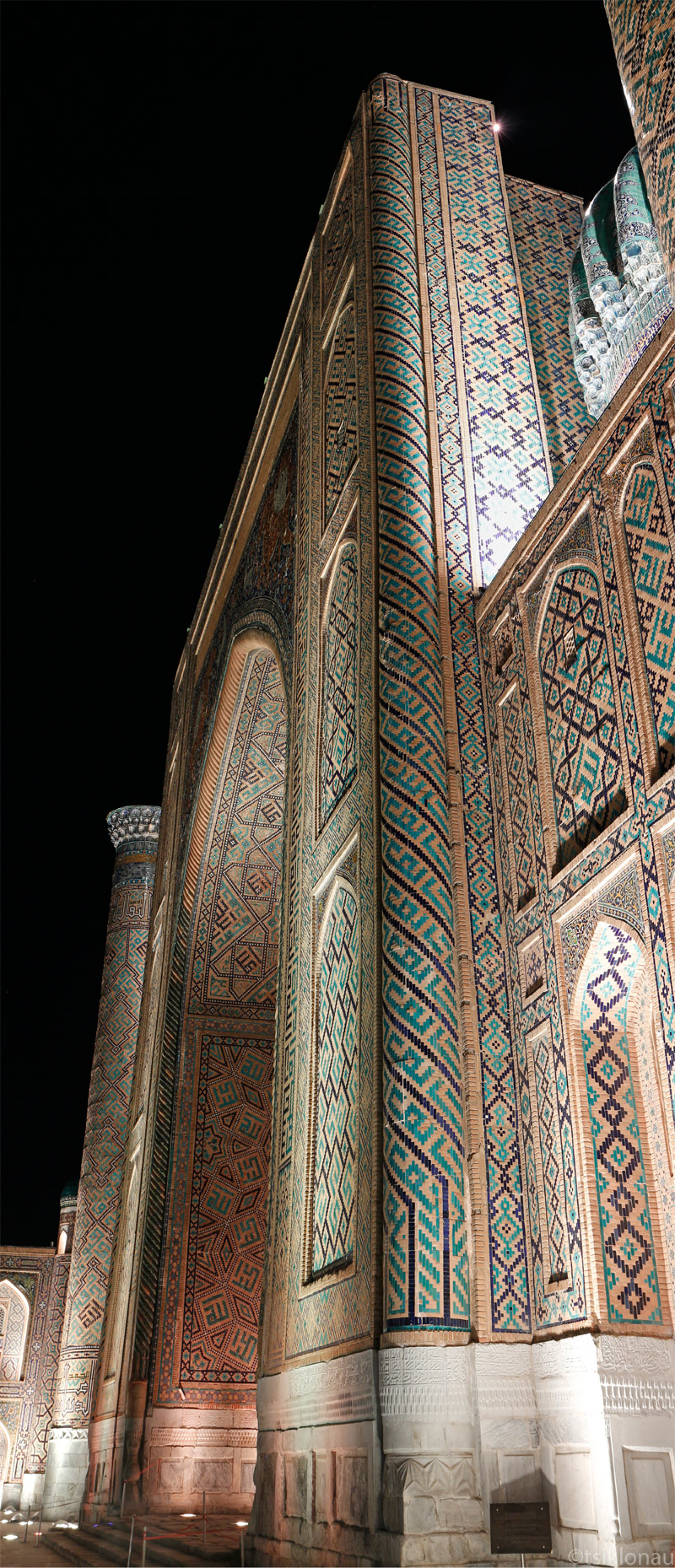
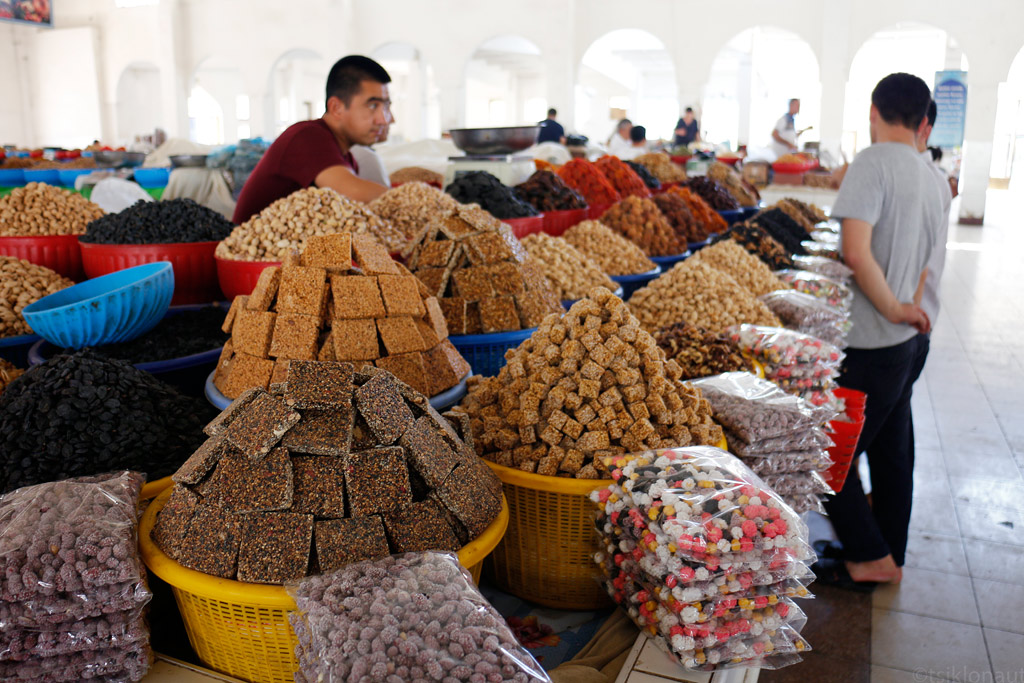
They got some nice oriental syle sweeties in Samarkand market, tasted real good.
Guidebooks seem to try to put people off Central Asia by telling that one shouldn’t travel there for food. True, the random roadhouse “restaurants” seem to have copied their menus from each other, mainly concentrating on a few staples such as noodle soup, kebab and plov, but the dishes still taste slightly different and mostly pretty good. In fact, the plov that they make is truly delicious. Possibly it has something to do with the varieties of rice that they are using (at markets one can see a whole array of rice varieties - something that is not really common in our corner of the world).
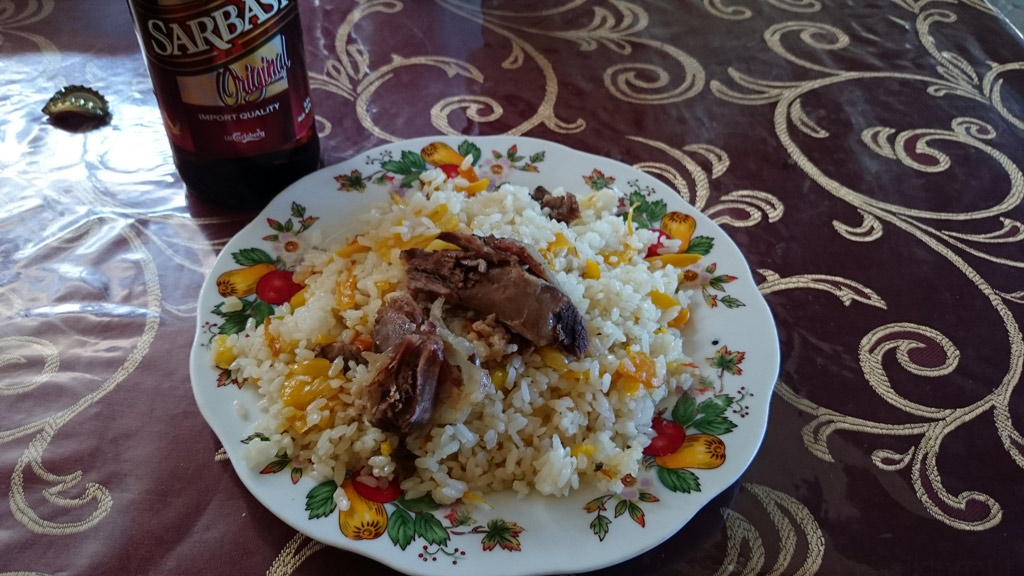
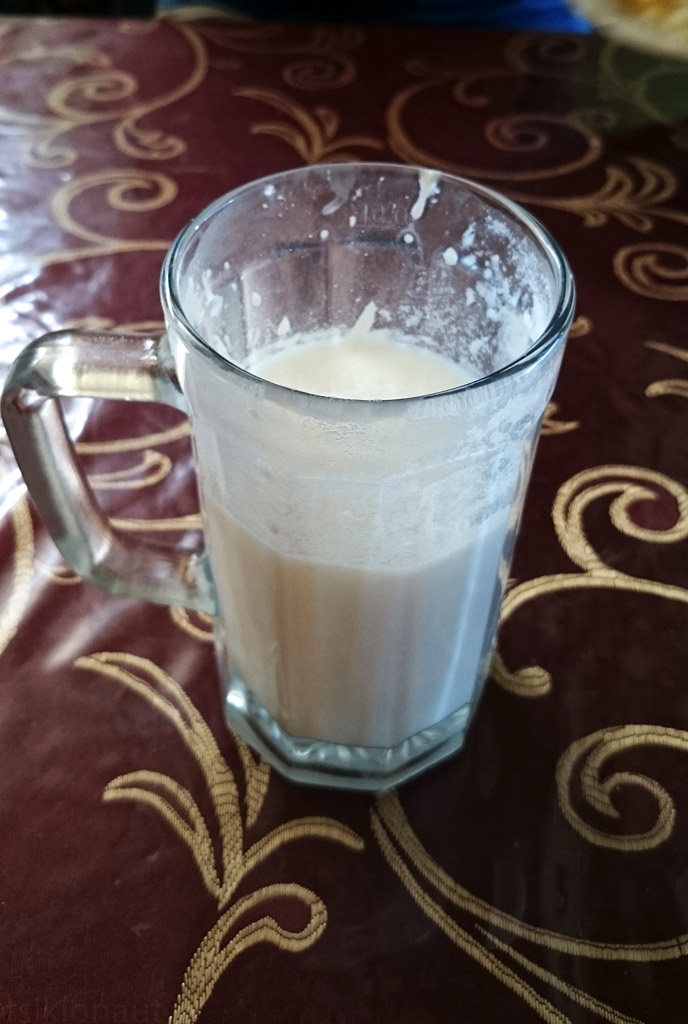
We also tried the local speciality - airan, which is basically fermented, fizzy milk. Surely, it is an acquired taste…
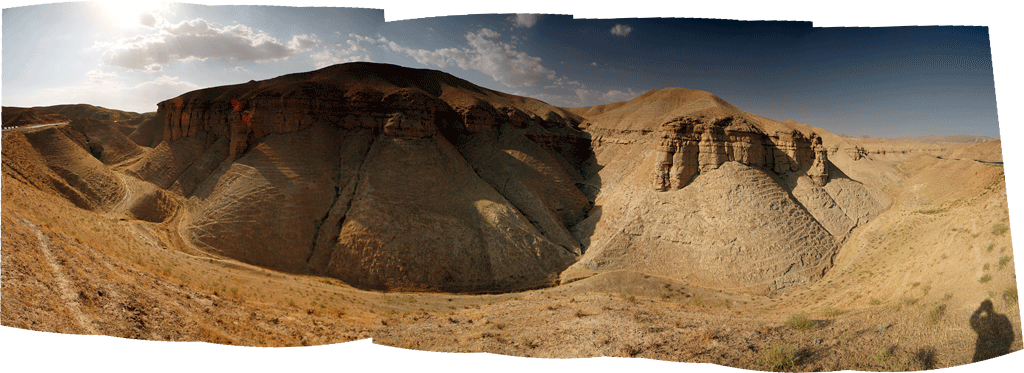
Southern Uzbekistan landscape.
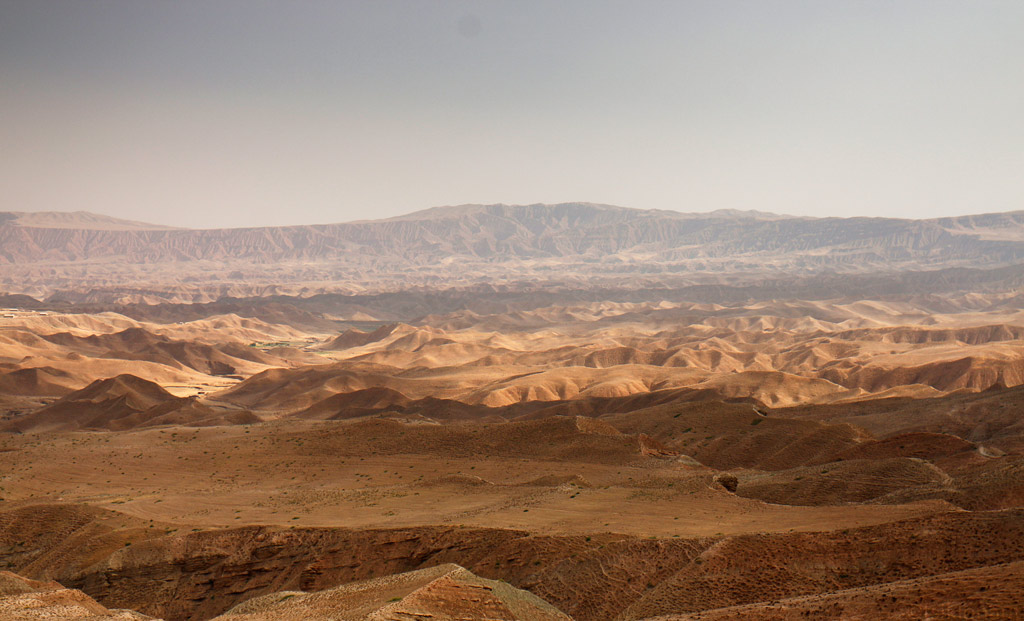
Hissar mountains.
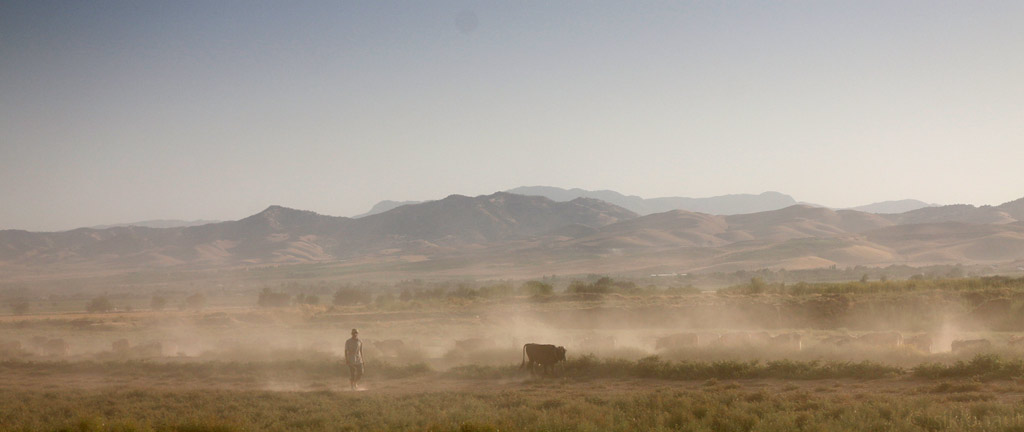
Remember, what a nice welcome to the country we had had? Well, the goodbye wasn’t as rosy. Although we are grateful we never had to deal with the infamous corrupt police in Uzbekistan, we got a truly frustrating experience with the officials while exiting the country as they performed an extremely thorough search of all our stuff, going through all our pockets and even wanting to see videos in our laptop. It all took nearly an hour, while they did not seem to have any real knowledge as to what they were supposed to look for.
Cheers,
Margus & Kariina
We’d always wondered what it is that takes people six hours to cross some border. Well, when we finally rolled out of the harbour’s territory half an hour before noon, we knew the answer. Most time is actually spent waiting. When after the search, immigration procedures, buying the insurance and paying the fee for using the bridge to roll off the ferry we’d finally reached the customs, there was a huge banner with all the process of moving through the port explained in pictures. Let’s say three minutes for passport control, five minutes for the search and so on. All in all, it seemed like half an hour’s job. In fact it seems that without all the waiting between those stages, it would almost be correct. But there was a lot of waiting. Especially considering that none of us had had breakfast.
So once we finally got spat out of the port, we quickly found a place to eat, where we devoured the whole set lunch - soup, salad, main dish, dessert and compote - and still didn’t feel like really full.
The city of Aktau wasn’t exactly attractive, so after fuelling up we headed out into the steppe. Quite soon after leaving Aktau we stumbled upon an interesting graveyard next to the highway. Or to put it more correct, it wasn’t a graveyard, but a necropolis. It really looked like a miniature town, with mausoleums of various sizes laid out on a street-like grid. As we were to discover later, those necropolises are actually very common in Central Asia.


We didn’t linger too long though. Not because of the nature of the place, but because of the heat. It was unbearable. Moving down the highway only offered slight relief as we felt like riding in a heated oven. Opening the visor in order to get more air produced made us feel like being targeted with a heat gun.
Luckily, the road was smooth and there was virtually no traffic. The only thing to watch out were the camels. But there weren’t exactly many of those either.

The roads in Kazakhstan can be very good...

Mangistau landscapes.

Mangistau.

After some 300 kilometres of riding through the steppe, with only one truck stop in-between, the Sun was low enough for us to start thinking of stopping for the day. With the vast, empty steppe expanding in all directions we simply turned off the highway and made our way through the low grass. After a few kilometres, with the road still in sight but relatively far away, we stopped.

You can literally ride hundreds of miles of this...
The lower the Sun hung above the horizon, the quicker the temperature dropped. We cooked some instant soup, pitched the tent, used a bottle of water for showering and enjoyed ourselves.


After the Sun had set, it became dark really quickly and countless stars lit up the sky… What a fantastic way to spend a night in a steppe!

Our Galactic Standard Million Star hotel suite (shared together with poisonous spiders, scorpions, snakes, lizards and other friendly bugs we encountered - unlike some, in a free nature we actually respect and love 'em all!)
At night the temperature must have dropped to +25 degrees Celsius (versus some +35 in the daytime), so it was very comfortable to sleep. Getting out of the tent minutes before sunrise we could almost say it was cold! However, as the Sun rose and started making its way up, the temperatures soared again.
We moved on towards Uzbekistan, down a very bumpy dirt track. All the time in the first or the second gear.

Hardened mud track to Uzbekistan border.
After entering Uzbekistan through a rather remote border post we rolled down a reasonably paved road that took us through… nothingness. Around a hundred kilometres passed without passing by any kind of village, roadhouse, and not even a camel. It was hot though, and our thirst grew by kilometre, so when our eyes finally came across some village on the horizon that wasn’t even on our maps, we willingly took the some five-kilometre detour to get there.
We had barely managed to park our bikes in front of the village store and go in to buy cold sodas, as seemingly half of the village gathered around us. Soon enough we and the villagers were posing for photos in front of our bikes. One of the fellows ran into the store and coming out of there with two bottles of cold beer, insisted that we take them with us as a present. What an introduction!

As the Sun was about to set, we rolled out of the village and a couple of kilometres down the highway before getting off the road and into the semi-desert. After around a kilometre of some nice riding through the dry landscape we decided to stop and pitch our tent.


Our Uzbek desert friend wanted part from our morning coffee, but we discovered her when we've already finished.

The next day we arrived in Kungrad (or Qongirot - the spelling of place names can be really confusing in Uzbekistan) from where a road branches off towards the town of Moynaq that used to lie on the shores of the Aral Sea. But before we could set off for Moynaq, we had to face a problem that we’d have throughout most of Uzbekistan - there was no petrol. The only fuel station selling petrol was not working due to a power cut, and the rest were only selling gas (most cars in Uzbekistan run on gas so there is basically no demand for petrol). Somehow we managed to track down some guy selling petrol in canisters from his backyard, and could continue our journey.

Searching for fuel in Uzbekistan villages...


Finally after a lot of search found one guy selling us few liters from his backyard.
Moynaq is a town with a grim story to tell. It used to sit on the shores of the Aral Sea (hence a fish on its logo), but after the development of cotton production in Uzbekistan drained the rivers that used to feed the sea, it shrank to a mere fraction of its original size. Today one cannot even glimpse the water from Moynaq. Instead, what used to be the sea bed is now basically desert that is covered with low shrubs that grow as far as the eye can see. The rusting ships serve as a reminder of the catastrophe.

Rusting ships on the dry Aral sea, one of the biggest eco-disasters man has ever created.



I simply had to take a ride around the Aral sea bottom. A great feeling, but soon I discovered it's a bit too soft sand on some spots....
Back in Kungrad, we spent another hour or two trying to find more petrol to keep us going. After being successful, we rode to Nukus where we had no choice to go to a hotel - the law requires tourists to register themselves within three days of arriving in the country, and to do that one has to stay in a hotel. What looked quite decent on the outside, turned out to be quite different on the inside. But considering that we only paid something like USD 16 for it (thanks to the black marker rate - officially, one night cost USD 30), perhaps it wasn’t that bad.

While the western part of Uzbekistan is almost devoid of people, the further east you move the more people there are. And it makes perfect sense - people are where there is water. For example, the famous town of Khiva sits in the valley of Amu-Darya river that separates Uzbekistan from Turkmenistan. Without it, Khiva would have never become the powerful, feared khanate it once was. To us, the mud brick buildings of Khiva brought back memories of the Persian desert city of Yazd, although while the old town of Yazd lives and breathes to this day, Khiva is more of a museum. Its old town mostly consists of mosques, medressas, the governor’s palace and a market.

Old city wall of Khiva.

Entrance.

Medressa. Behind, the fat Kalta Minor was ment to be a minaret high enough to see from Khiva to Bukhara, but the ruler died before it was completed.

View to Khiva from the highest minaret.
..:: Click to listen soundscape of a live band playing below in the city, with surreal echoes from the mud-walls ::...

Khivan door.

Burials of famous people.

The ex-slave chambers have been nicely converted into small businesses, this one's electronics repair.

Khiva market - bought some very tasty peanuts from here.
Just like Khiva, both Samarkand and Bukhara were once too built into oases. At first we were stunned by the resemblance of their most famed buildings to those we’d seen in Iran, but found out that they were in fact designed by artists who were forcefully brought to today’s Uzbekistan from Persia. The mosques and medressas we saw in Bukhara and Samarkand are a true work of art.
...:: Click to listen Uzbek street musician for the soundcape ::...



Bukhara market.

Timurid architecture. This one's actually very controversial among islamic scholars since it draws animals (see the two tigers up), it's a very un-islamic way building things.

The stunning ceiling of a mausoleum dedicated to Timur's sister.

Over a half millennia old, still stunning.


You get very decent melons everywhere, we bought one, it was superb.

The streets are so tight you can only walk or ride two-wheeled vehicles, as any proper old city should be.

Doorway to someone's home.

Uzbek ice-cream names are rather funky.


Bukharan city life.

Really impressive fort.

Samarkand.


They got some nice oriental syle sweeties in Samarkand market, tasted real good.
Guidebooks seem to try to put people off Central Asia by telling that one shouldn’t travel there for food. True, the random roadhouse “restaurants” seem to have copied their menus from each other, mainly concentrating on a few staples such as noodle soup, kebab and plov, but the dishes still taste slightly different and mostly pretty good. In fact, the plov that they make is truly delicious. Possibly it has something to do with the varieties of rice that they are using (at markets one can see a whole array of rice varieties - something that is not really common in our corner of the world).


We also tried the local speciality - airan, which is basically fermented, fizzy milk. Surely, it is an acquired taste…

Southern Uzbekistan landscape.

Hissar mountains.

Remember, what a nice welcome to the country we had had? Well, the goodbye wasn’t as rosy. Although we are grateful we never had to deal with the infamous corrupt police in Uzbekistan, we got a truly frustrating experience with the officials while exiting the country as they performed an extremely thorough search of all our stuff, going through all our pockets and even wanting to see videos in our laptop. It all took nearly an hour, while they did not seem to have any real knowledge as to what they were supposed to look for.
Cheers,
Margus & Kariina



